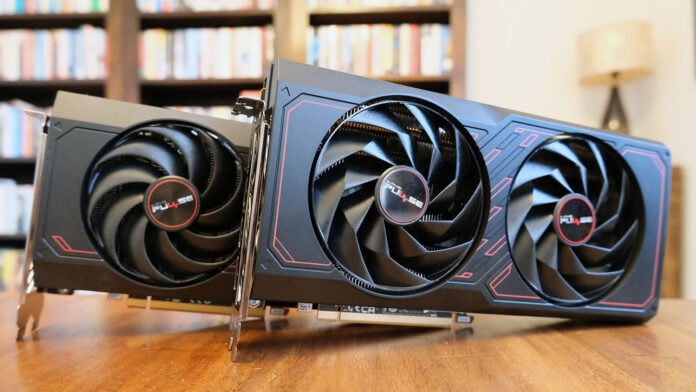AMD’s efforts to invigorate the mainstream discrete graphics card market take the form of the Radeon RX 7600 8GB GPU released last May and starting at $269 / £249. Based on taking every available transistor on the purpose-built Navi 33 die, the card proves a sensible choice for those starved of budget. Partner models duke it out with rival GeForce RTX 4060 8GB as premier solutions for high-framerate 1080p gaming.
Truth to told, it remains a difficult task for either AMD or Nvidia to build a better GPU for around the same price. Using Navi 32 or Ada 106 silicon – the next GPUs dies in respective catalogues – is too expensive for ~$300 cards, so lateral thinking is required.
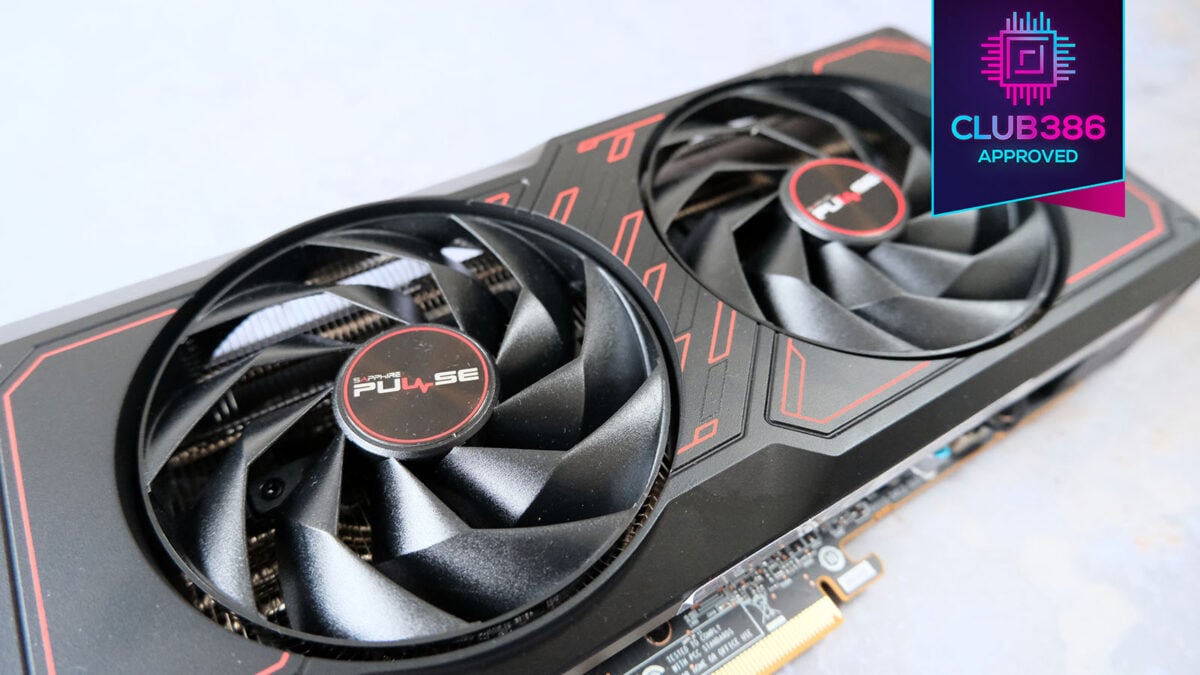
Sapphire Pulse Radeon RX 7600 XT
£249 / $269
Pros
- Great FHD performance
- Solid Pulse design
- FSR technology
Cons
- No clear benefit over 8GB
Club386 may earn an affiliate commission when you purchase products through links on our site.
How we test and review products.
AMD’s GPU product division’s answer to this positioning conundrum is the Radeon RX 7600 XT. Working out exactly what it brings to the table is a job fit for the Club386 Table of Doom™. Let’s take a closer look when compared to other mainstream peers from the previous generation.
| Radeon | RX 7600 XT | RX 7600 | RX 6600 XT | RX 6600 |
|---|---|---|---|---|
| Launch date | Jan 24 | May 23 | Aug 21 | Oct 21 |
| Codename | Navi 33 | Navi 33 | Navi 23 | Navi 23 |
| Architecture | RDNA 3 | RDNA 3 | RDNA 2 | RDNA 2 |
| Process (nm) | 6 | 6 | 7 | 7 |
| Transistors (bn) | 13.3 | 13.3 | 11.1 | 11.1 |
| Die size (mm2) | 204 | 204 | 237 | 237 |
| PCIe | Gen 4 x8 | Gen 4 x8 | Gen 4 x8 | Gen 4 x8 |
| Compute Units | 32 of 32 | 32 of 32 | 32 of 32 | 28 of 32 |
| ALU | 2,048 | 2,048 | 2,048 | 1,792 |
| Boost clock (MHz) | 2,755 | 2,655 | 2,589 | 2,491 |
| Peak FP32 GFLOPS | 22,568 | 21,750 | 10,605 | 8,928 |
| RT cores | 32 | 32 | 32 | 28 |
| ROPs | 64 | 64 | 64 | 64 |
| Infinity Cache (MB) | 32 | 32 | 32 | 32 |
| Memory size (GB) | 16 | 8 | 8 | 8 |
| Memory type | GDDR6 | GDDR6 | GDDR6 | GDDR6 |
| Memory bus (bits) | 128 | 128 | 128 | 128 |
| Memory clock (Gbps) | 18 | 18 | 16 | 14 |
| Bandwidth (GB/s) | 288 | 288 | 256 | 224 |
| Bandwidth inc IC (GB/s) | 476.9 | 476.9 | 444.9 | 412.9 |
| AV1 encode | Yes | Yes | No | No |
| Display outputs | HDMI 2.1a DP 2.1 | HDMI 2.1a DP 2.1 | HDMI 2.1 DP 1.4 | HDMI 2.1 DP 1.4 |
| Power (watts) | 190 | 165 | 160 | 132 |
| Launch MSRP ($) | 329 | 269 | 379 | 329 |
Radeon RX 7600 XT Analysis
Read across the first 14 rows of the table. Do it again. The only meaningful difference between Radeon RX 7600 XT and vanilla RX 7600 is a 100MHz higher boost clock, leading to 3.8% more compute throughput.
Scan down the rest of the specifications and you’ll realise it’s more of the same. The memory bus, speed, and Infinity Cache remain identical. However, AMD makes the real distinction between the two models by installing a 16GB framebuffer on the new GPU, which is double that of RX 7600. These two additions – frequency and framebuffer – extend base board power from 165W to 190W.
One can argue this value-add in two diametrically opposed ways. On the one hand, a few games do benefit from a >8GB framebuffer, particularly when rendering at a QHD resolution, so anything that can be done to remove this obstacle is a good thing. The counterpoint is that framebuffer limitations rarely surface at the intended 1080p resolution, naturally lessening the appeal of this card. Extending this line of thinking, the decision to equip a Radeon RX 7600-class of card with 16GB of memory is more of a marketing decision than real-world benefit.
Taking a calculated gamble, RX 7600 XT comes in at $329 / £329 and butts heads against in-market GeForce RTX 4060 8GB. And, you know, 16GB always looks better on a box than 8GB.
Sapphire Quality
The good folk over at Sapphire sent me a Pulse version of the Radeon RX 7600 XT. There is no Toxic, Nitro, or Pure model, actually, and that makes sense because achieving the keenest recommended pricing is key for this GPU’s success in the cutthroat mid-range space.
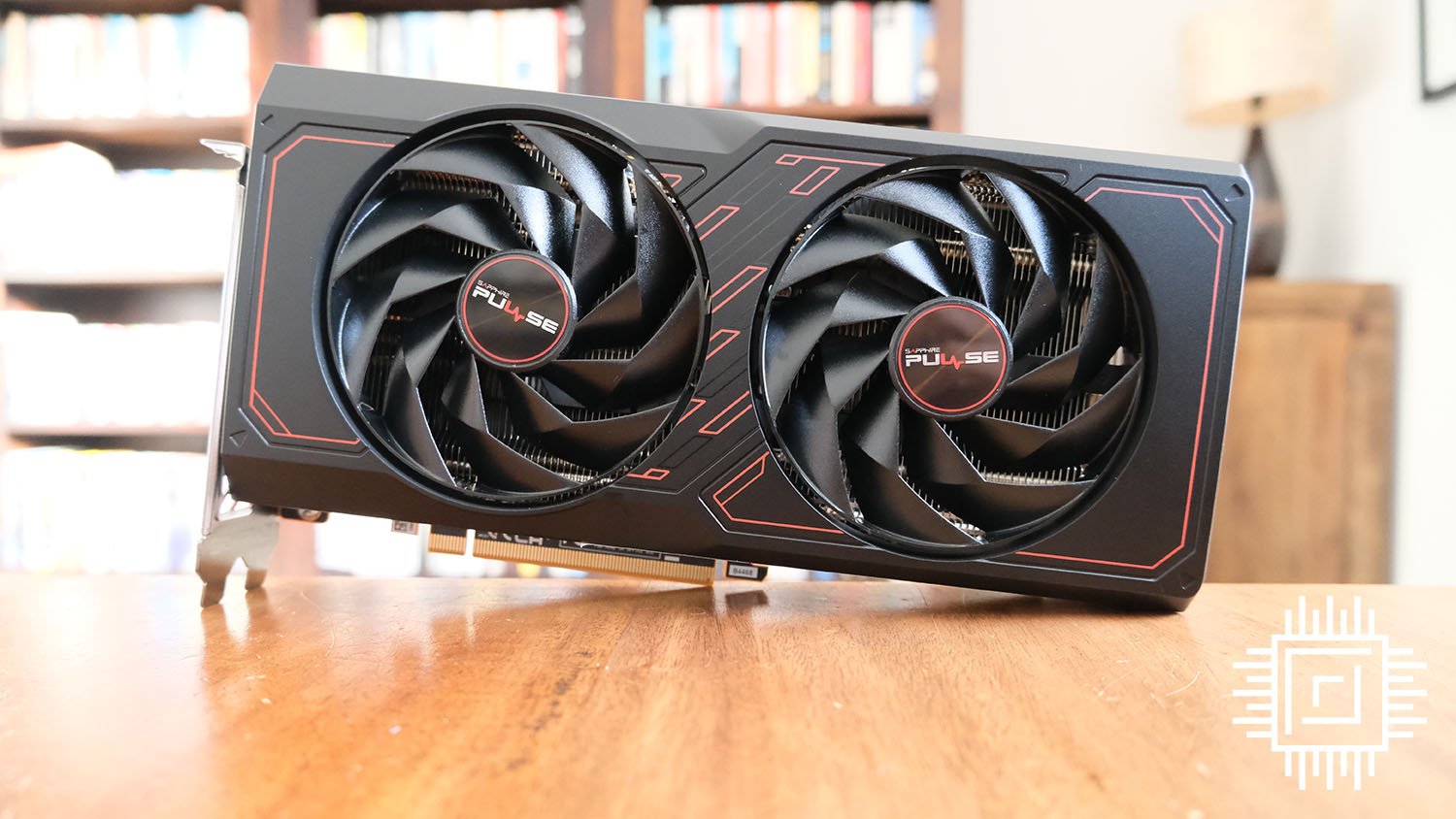
You may be inclined to think the card is a carbon copy of the 8GB-equipped model I reviewed last year. After all, the main changes are a doubling of RAM and a marginally higher core speed. Sapphire, however, uses a fundamentally different heatsink design this time around.
The beefier card measures 250mm long, 129.25mm high, and 44.56mm thick, making it larger in every direction than its non-XT sibling. Sapphire’s total board power of 192W is par for the course, meaning a substantial cooling apparatus is understandable. This all translates to a weight of 792g, compared to just 611g for the svelte 8GB version.
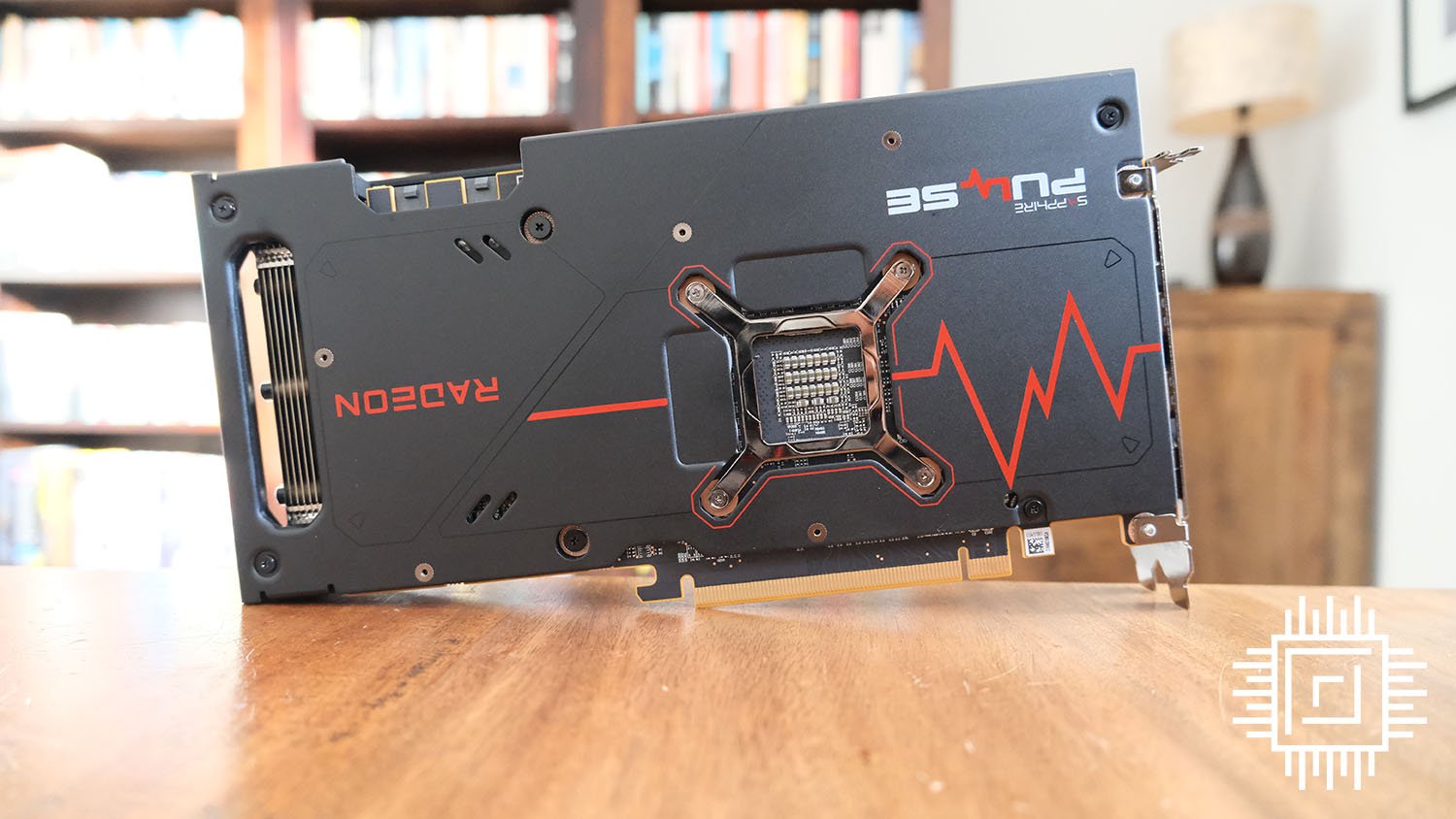
That’s not to say the RX 7600 XT Pulse is a porky card. Far from it, and Sapphire has the common sense not to turn a mainstream GPU into a senseless and cost-inducing 300mm-long behemoth equipped with three fans and more heatpipes than days of the week.
Pulse cards tend to shy away from fancy designs and RGB illumination. RX 7600 XT 16GB is no different in this regard, and I’m a fan, if you excuse the pun, of the minimalist design punctuated by flashes of red. Build quality is good, and no support is required other than screwing into the PCIe x16 slot. Like before, AMD restricts the electrical connectivity to PCIe 4.0 x8, but that’s no major issue on a card with these modest credentials.
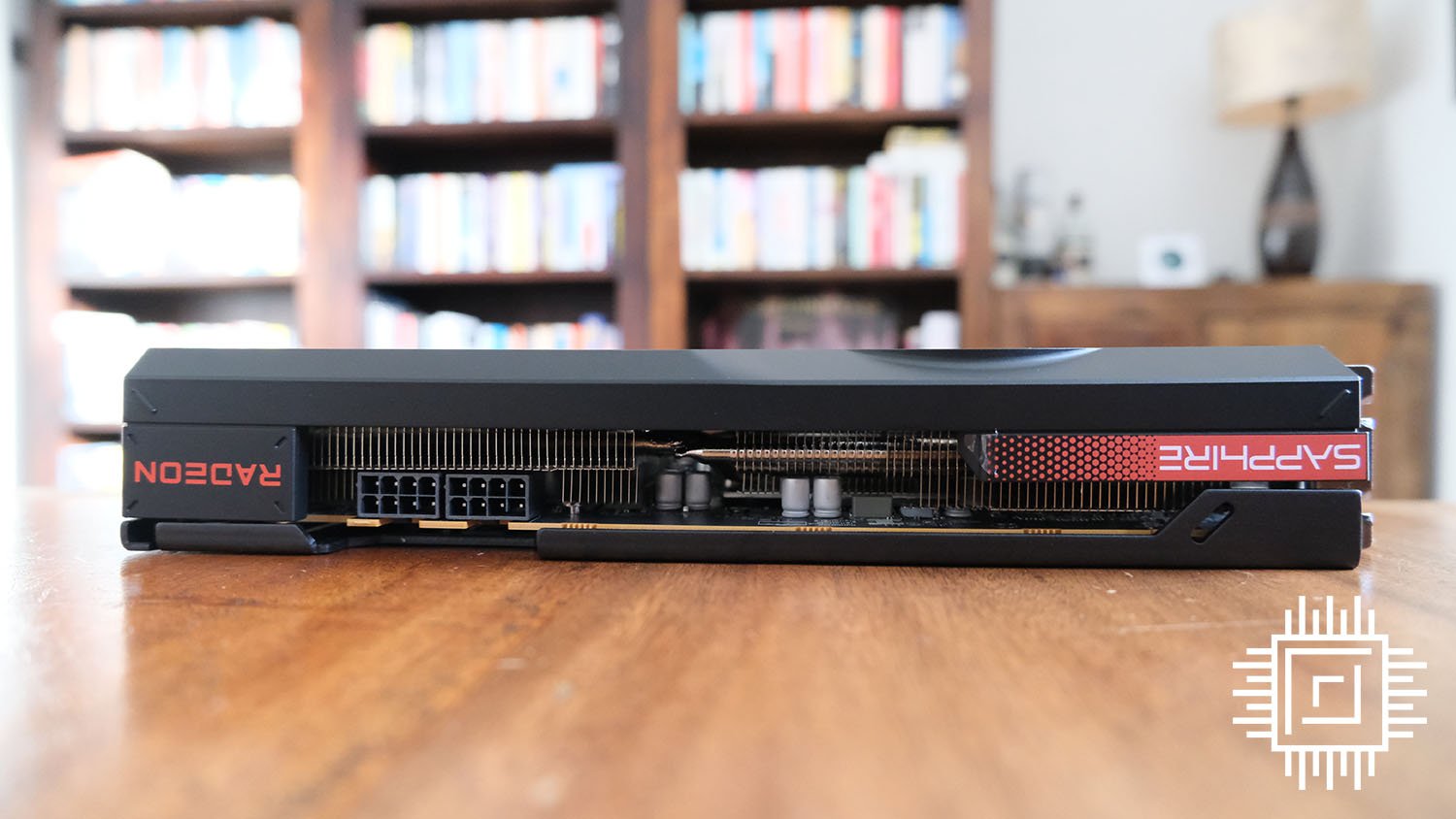
See you later, 12VHPWR. Pulse sticks to the tried-and-trusted dual 8-pin PCIe connectors – vanilla RX 7600, if you call, has a single 8-pin – so there’s plenty of power on tap if you’re indulging in some overclocking.
Sapphire recommends a 600W PSU, but I reckon you can get away with 500W assuming the supporting cast isn’t overclocked.
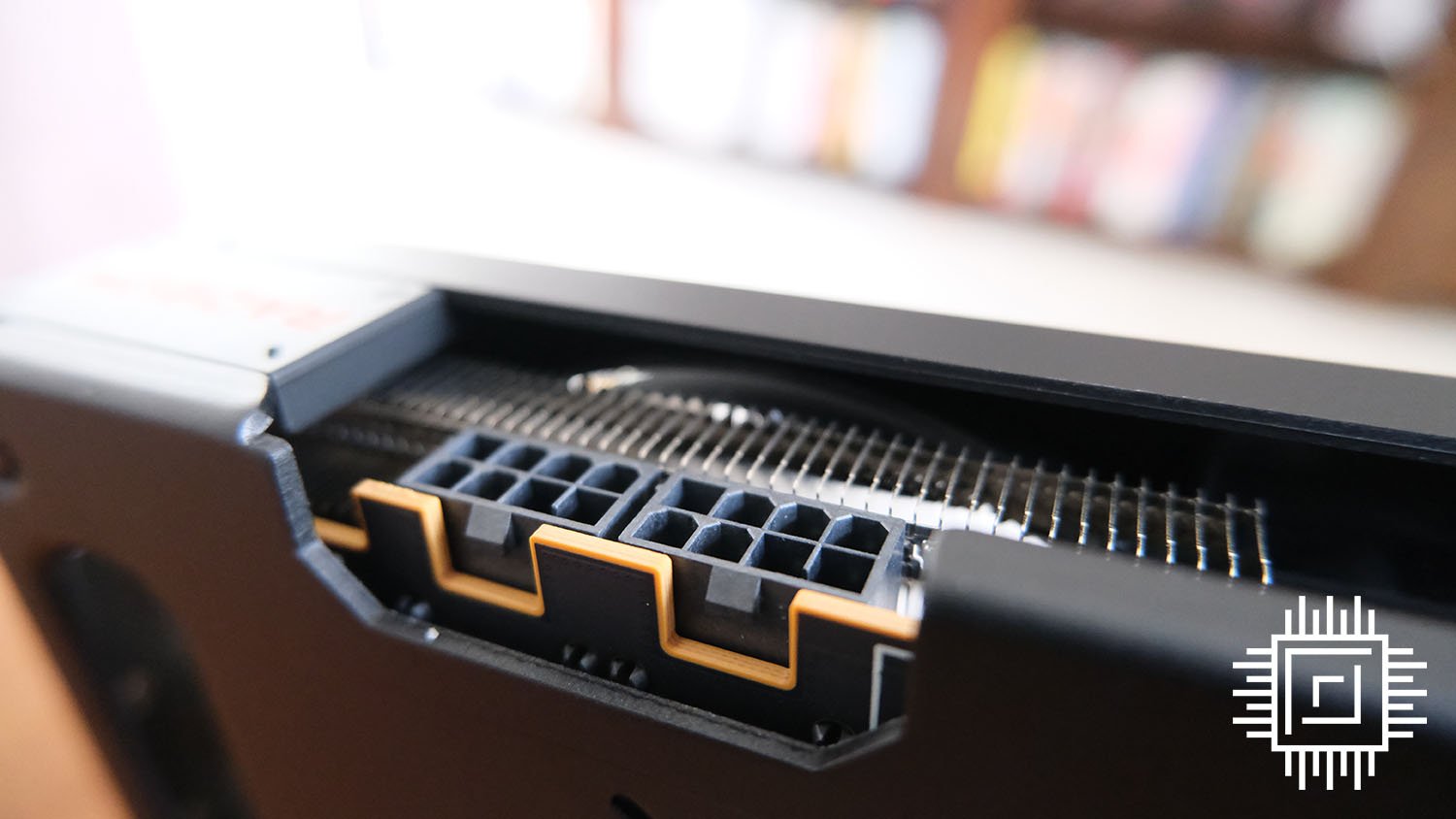
It would be remiss not to push the standard 2,755MHz boost clock out a little considering the amount of effort placed into cooling. Sapphire duly obliges by pumping the core up to 2,810MHz. Not enough to make a meaningful difference to framerates, to be sure, but every little helps when the going gets tough at QHD.
I noted the two fans remain switched off until GPU temperature escalates up to around 55°C. From then on, the ramp is steady and predictable. As you will see later on, the card goes about its pixel business in a restrained manner.
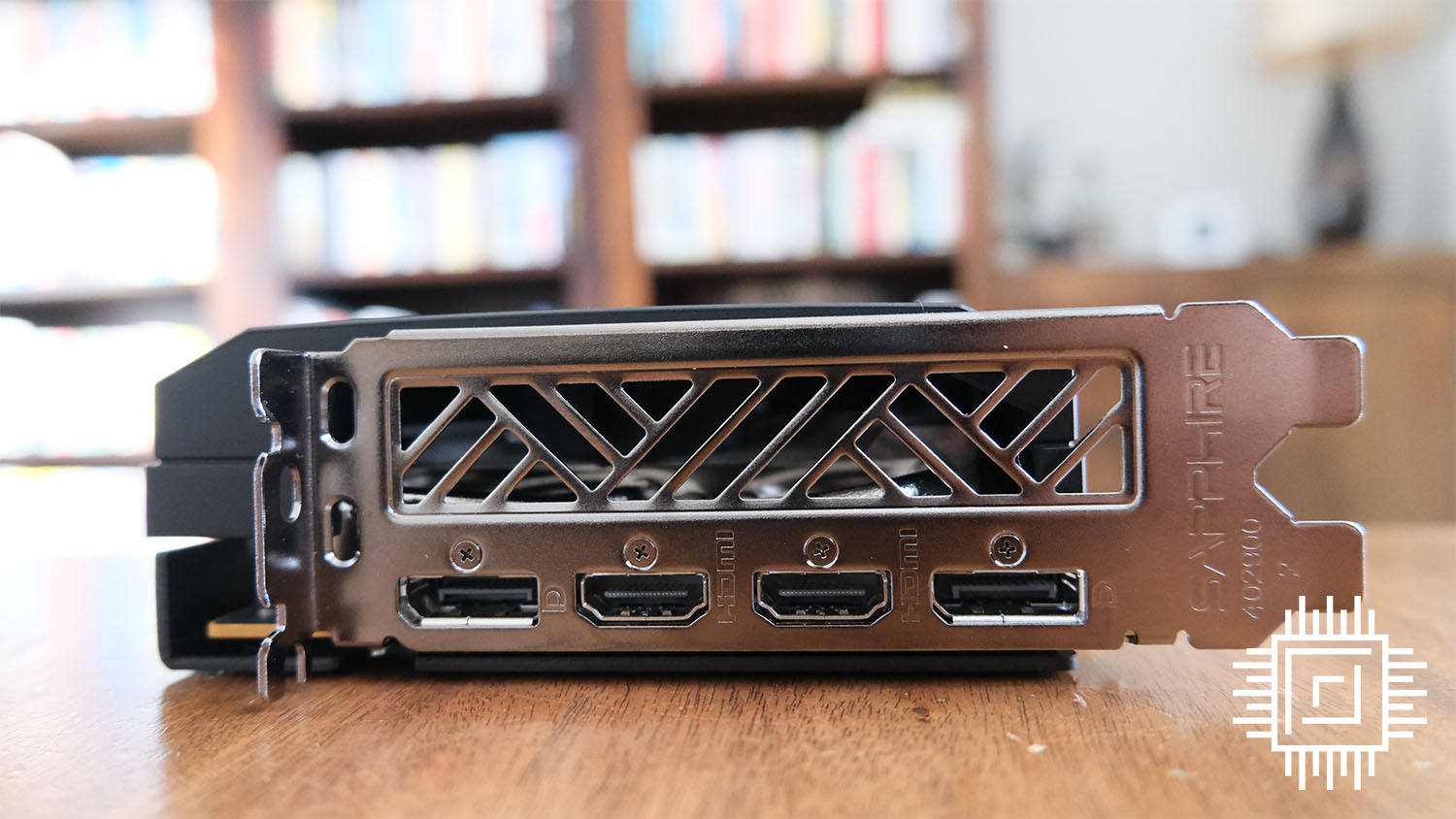
Another changeup from regular RX 7600 rests with outputs, whose single HDMI 2.1 and triple DisplayPort 2.1 is replaced by two of each. Capable of driving four displays, it’s horses for courses, as either arrangement works fine in a regular multi-monitor setup.
So far, this is one of those does-what-it-says-on-the-tin type cards. Let me now show you how it stacks up against a whole heap of relevant competition.
Performance
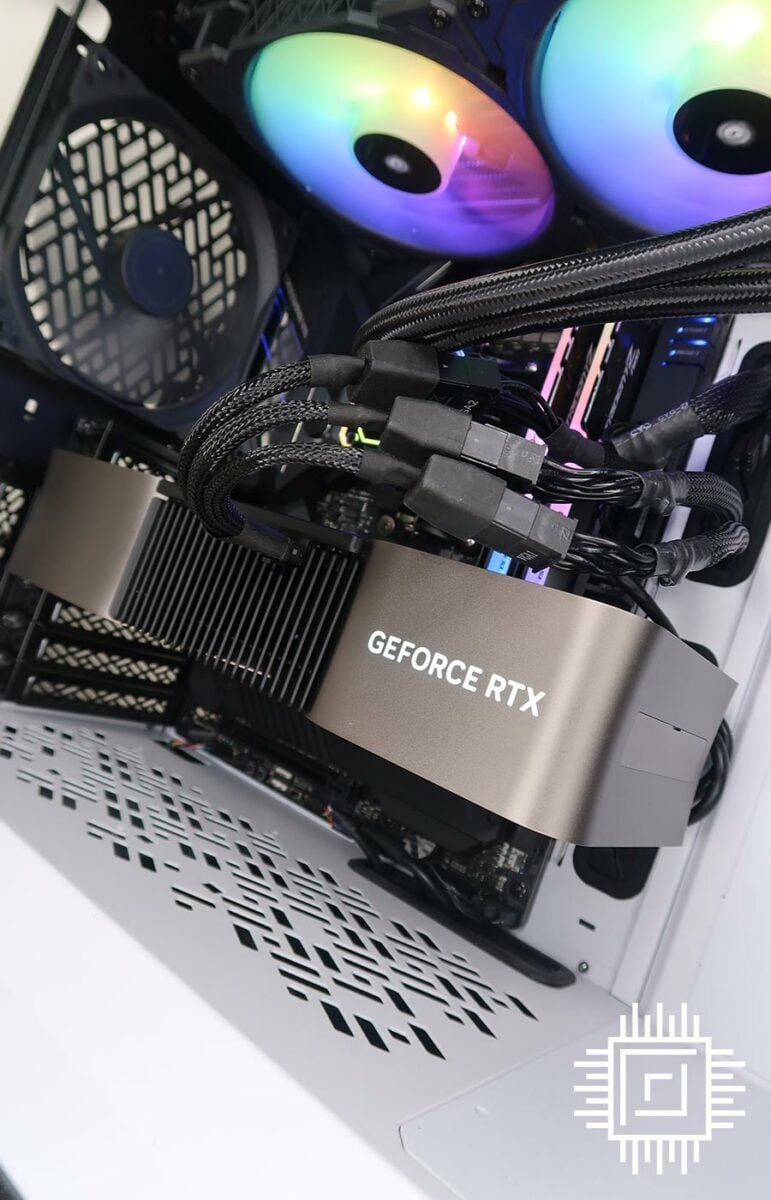
Our 5950X Test PCs
Club386 carefully chooses each component in a test bench to best suit the review at hand. When you view our benchmarks, you’re not just getting an opinion, but the results of rigorous testing carried out using hardware we trust.
Shop Club386 test platform components:
CPU: AMD Ryzen 9 5950X
Motherboard: Asus ROG X570 Crosshair VIII Formula
Cooler: Corsair Hydro Series H150i Pro RGB
Memory: 32GB G.Skill Trident Z Neo DDR4
Storage: 2TB Corsair MP600 SSD
PSU: be quiet! Straight Power 11 Platinum 1300W
Chassis: Fractal Design Define 7 Clear TG
Our trusty test platforms are nearing retirement, yet it is it testament to the Ryzen 9 5950X build that our twin AM4 rigs continue to function reliably irrespective of the numerous graphics cards thrown at it.
3DMark
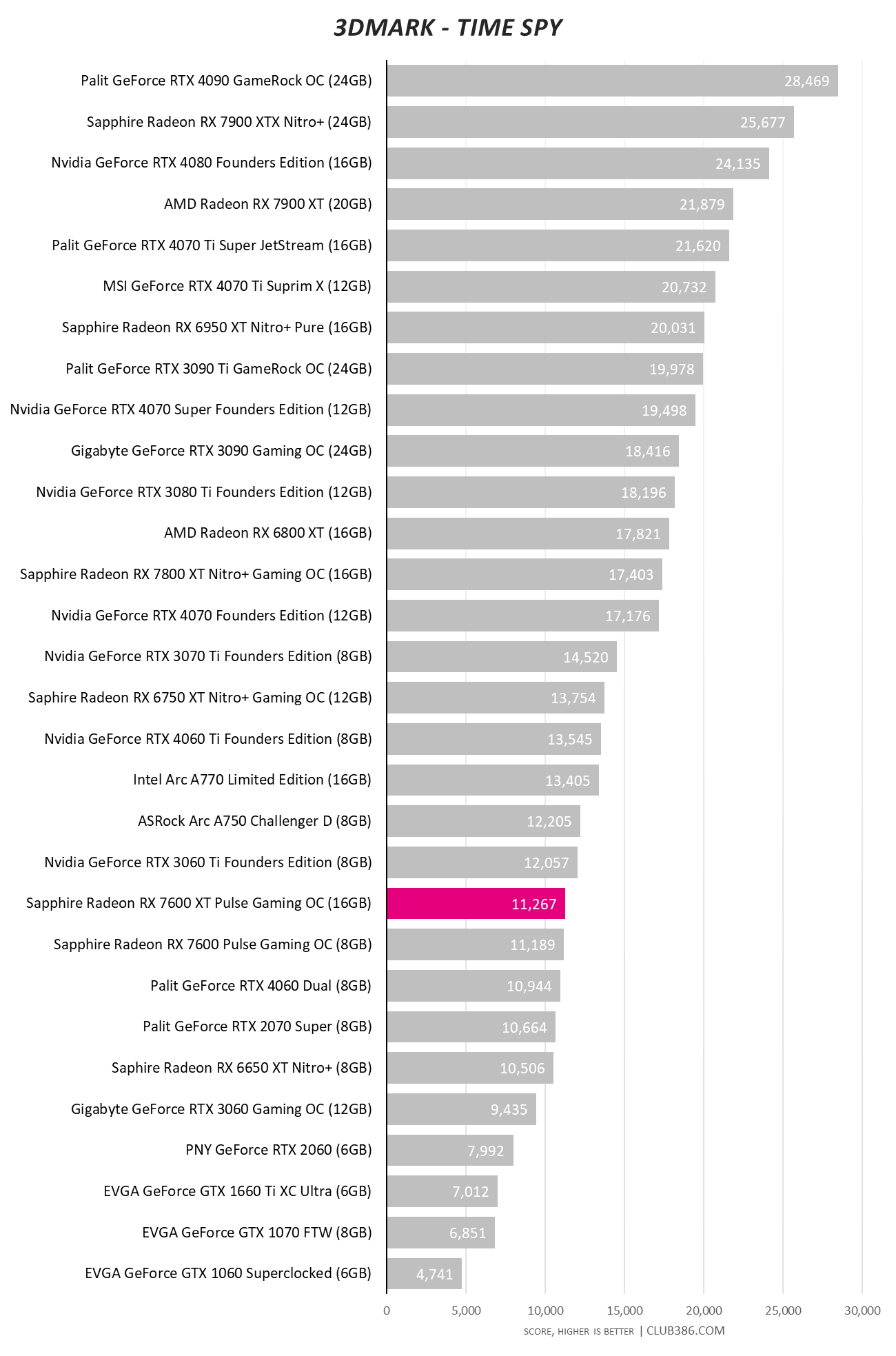
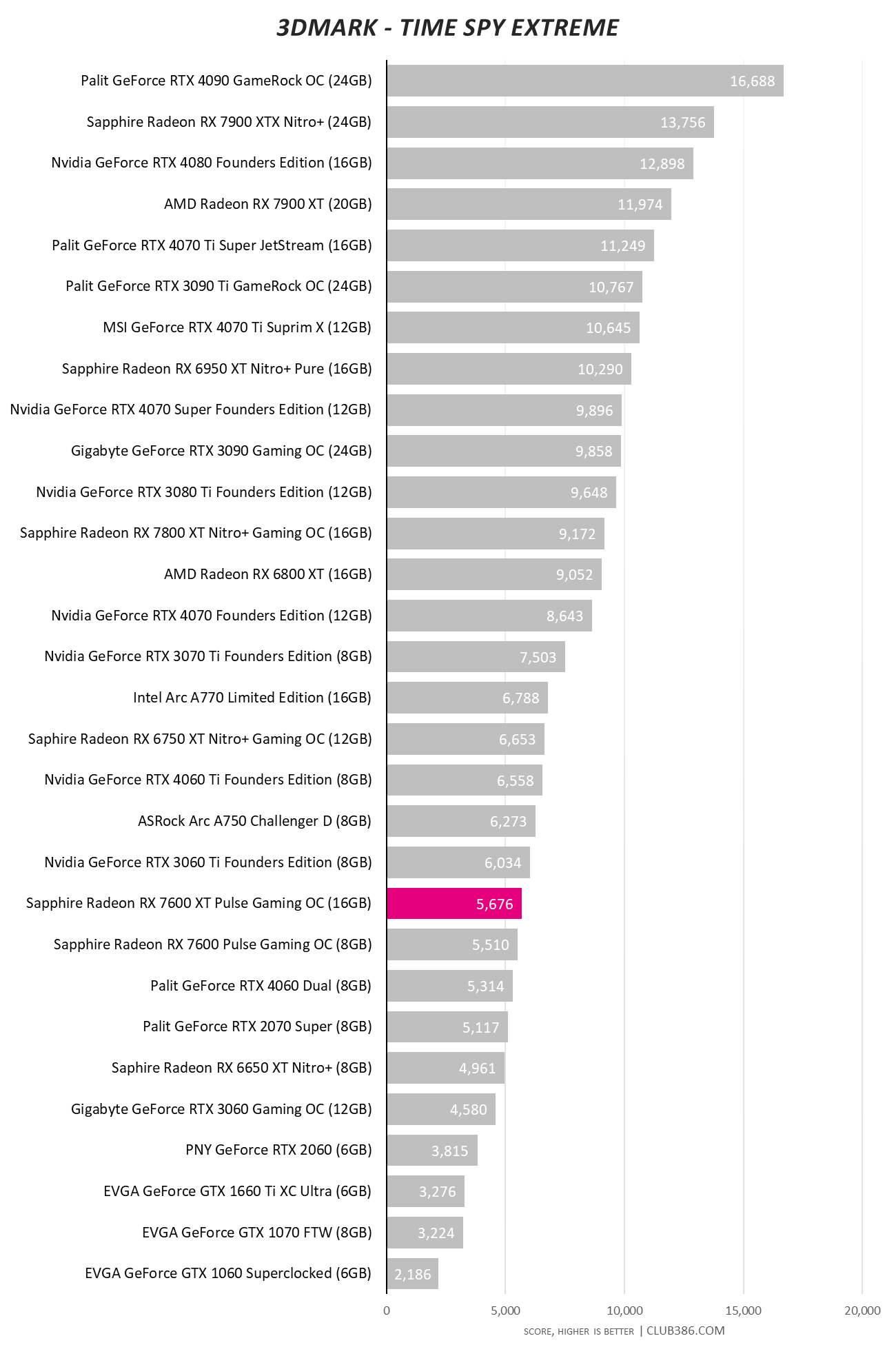
For the reasons mentioned above, there’s little reason to expect a significant performance improvement over the 8GB model; remember that both models feature a nigh-on identical architecture save for double the framebuffer on the card in for review today.
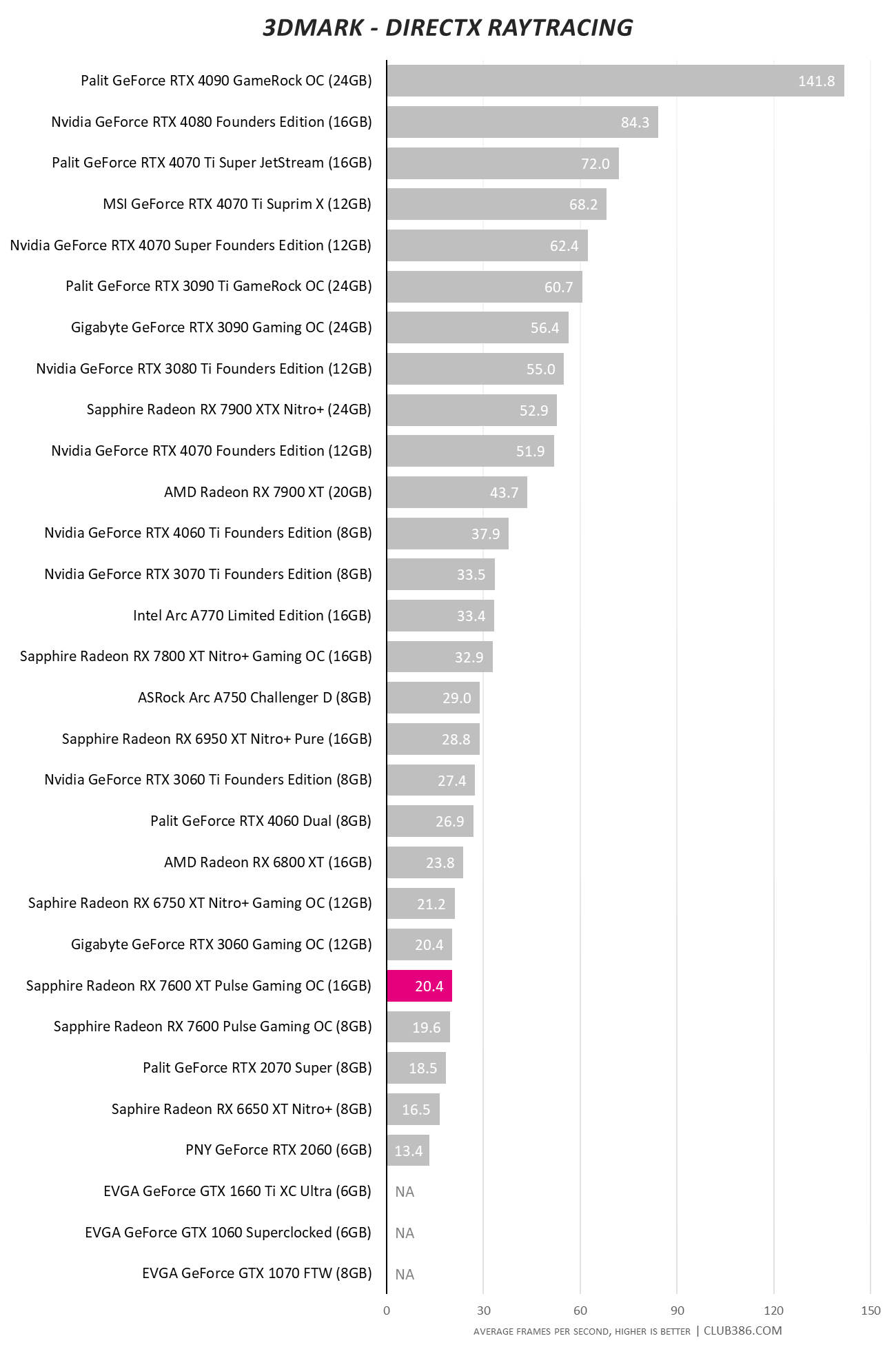
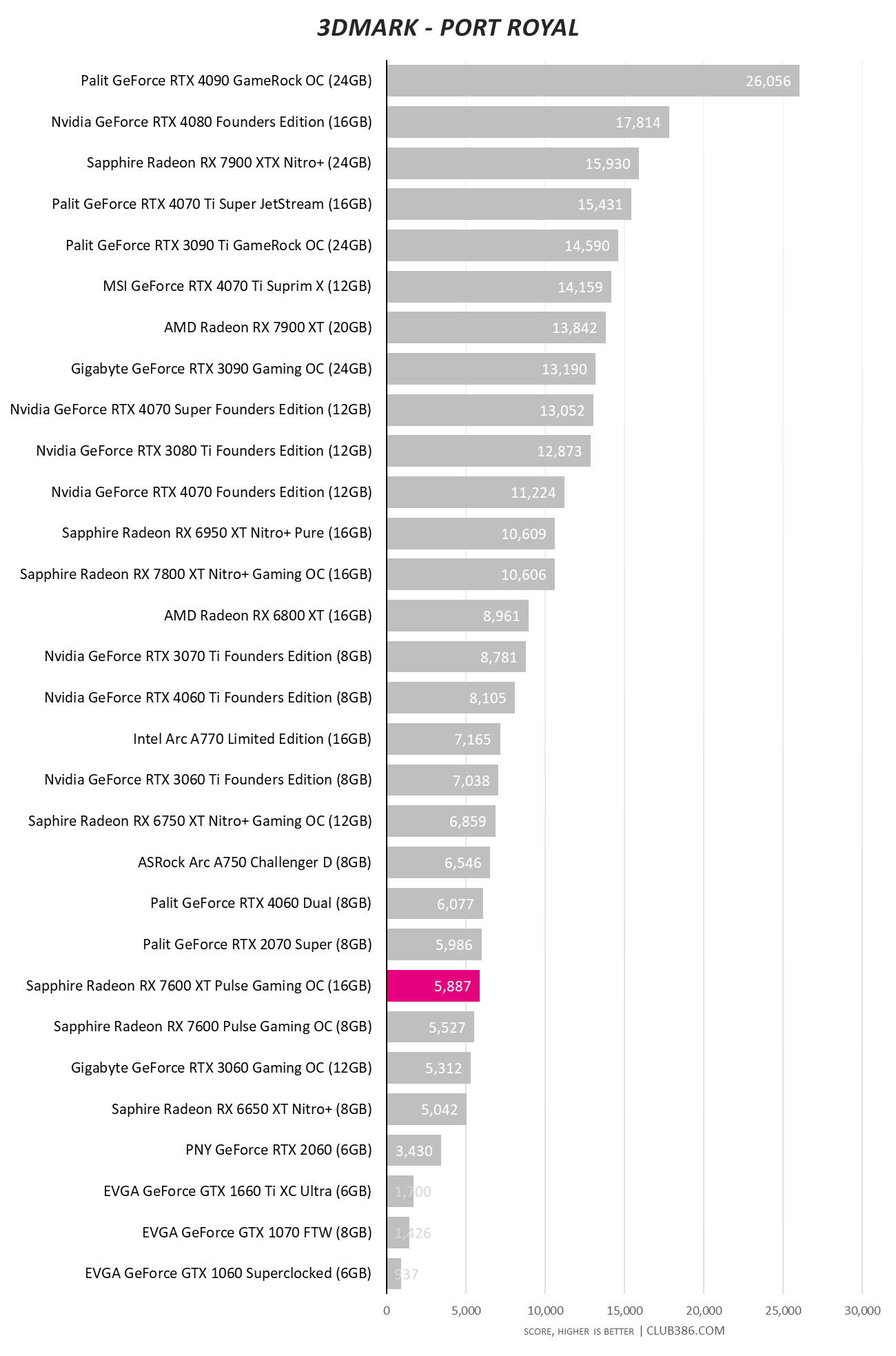
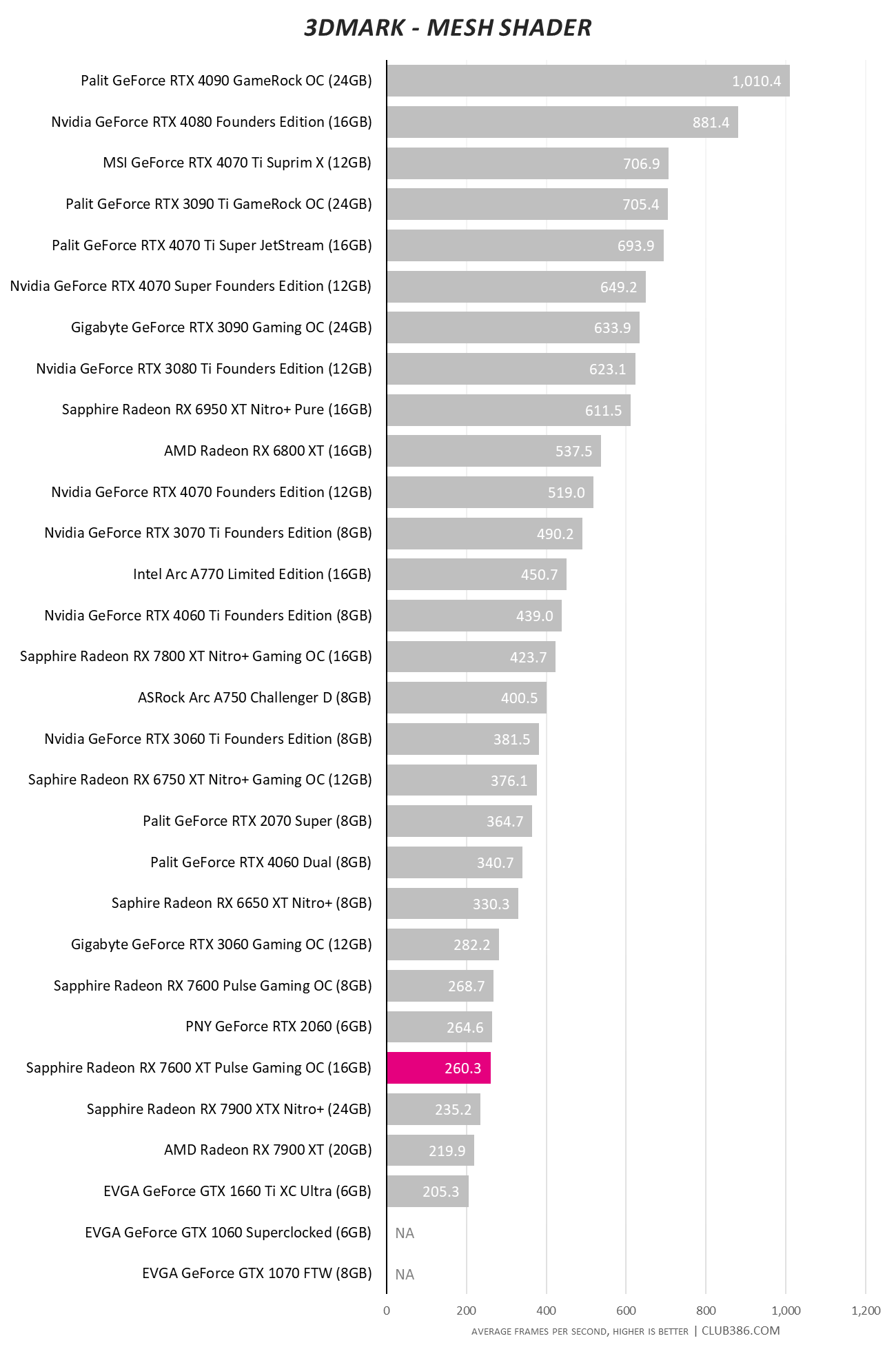
Most of the feature tests are not limited by framebuffer, as shown by the closeness of results between the 8GB and 16GB cards.
Gaming
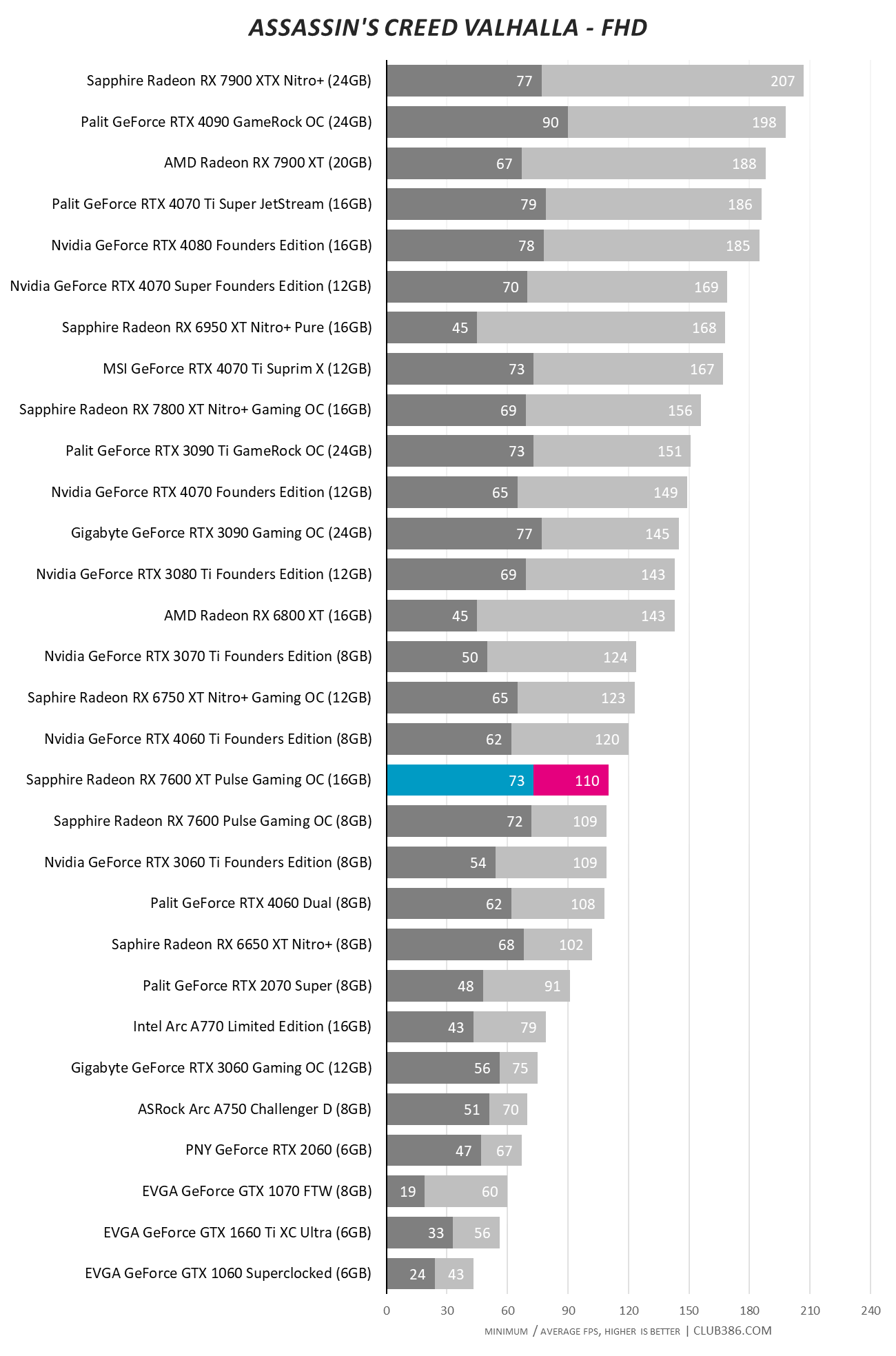
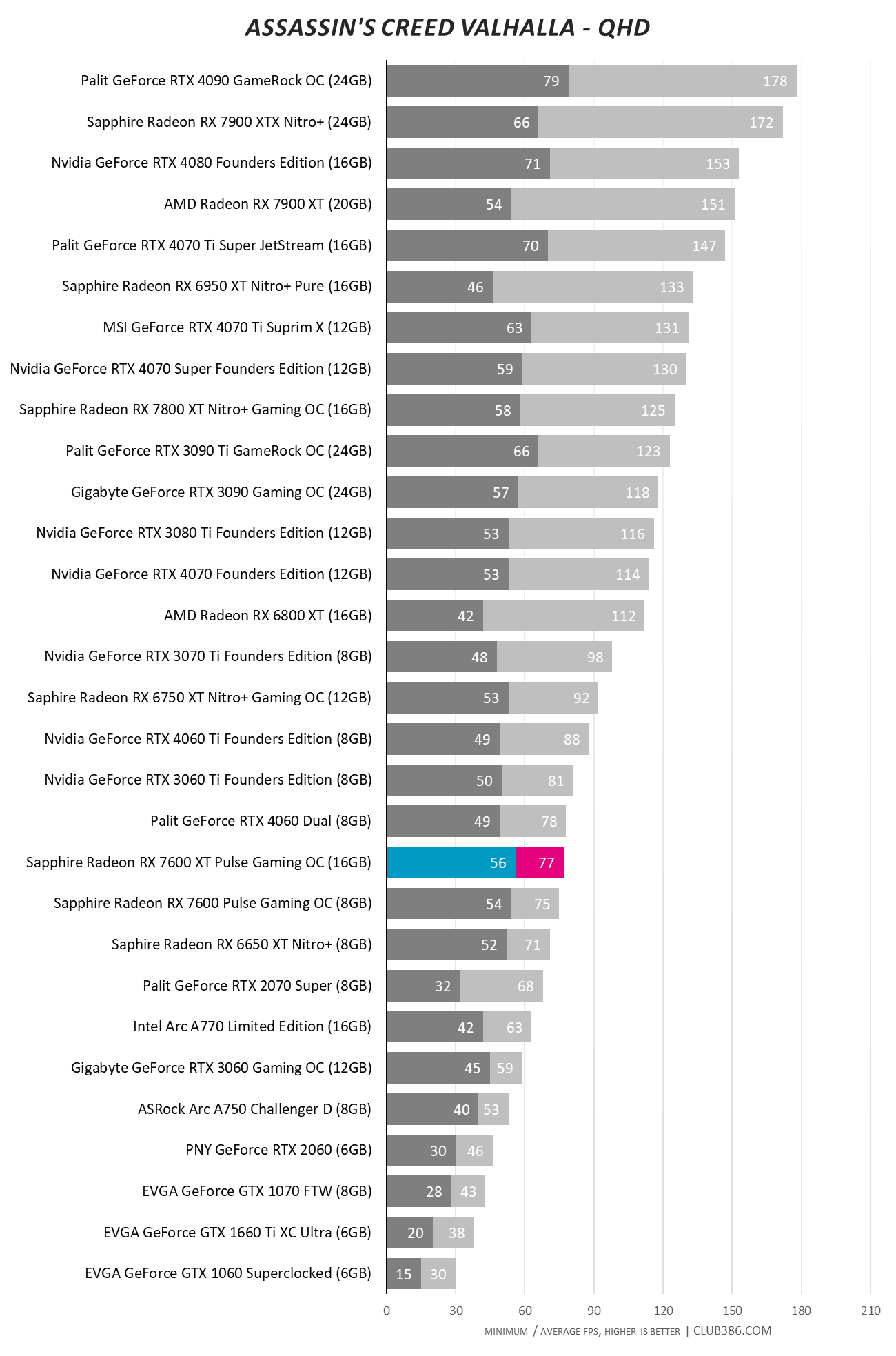
Assassin’s Creed Valhalla runs just fine on mid-range GPUs. I thought perhaps the minimum or lowest 0.1 or 1 per cent would be different, but this is not the case.
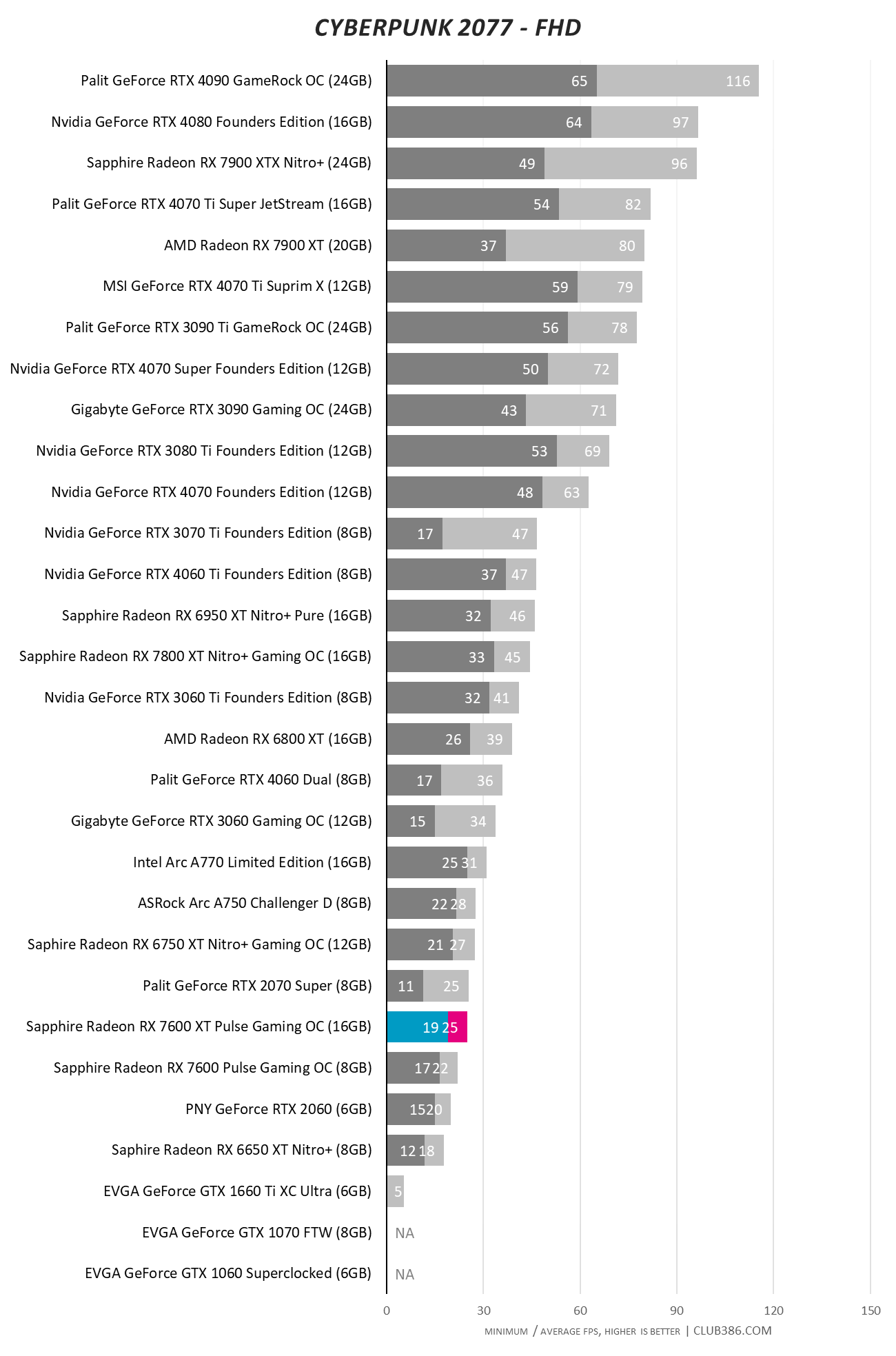
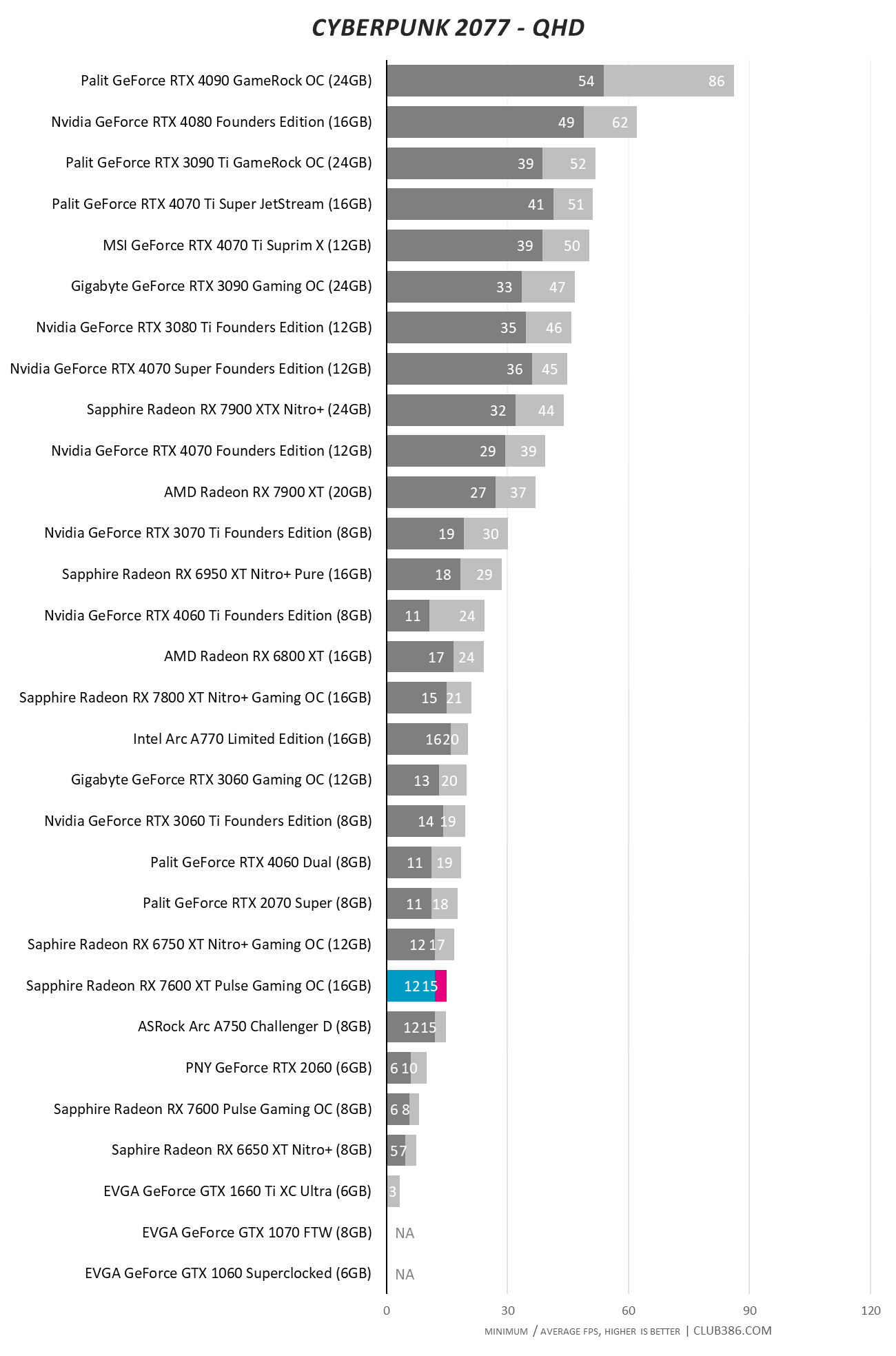
The crusher of GPUs, running Cyberpunk 2077 at ray tracing ultra settings does exhibit minor benefit of having more VRAM on modest GPUs.
The increase is largely academic, however, as the framerates are too low to be playable, but more on that later.
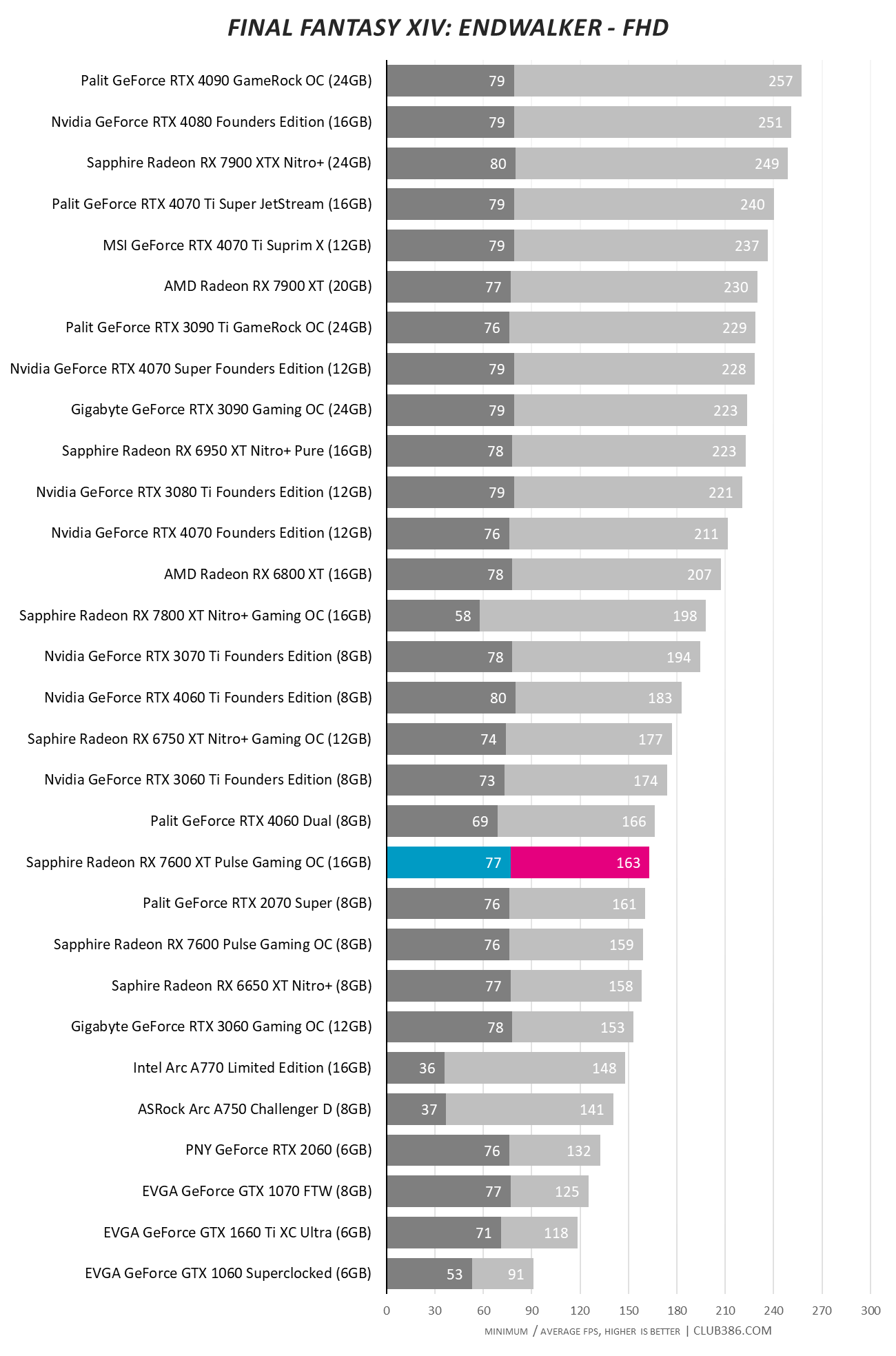
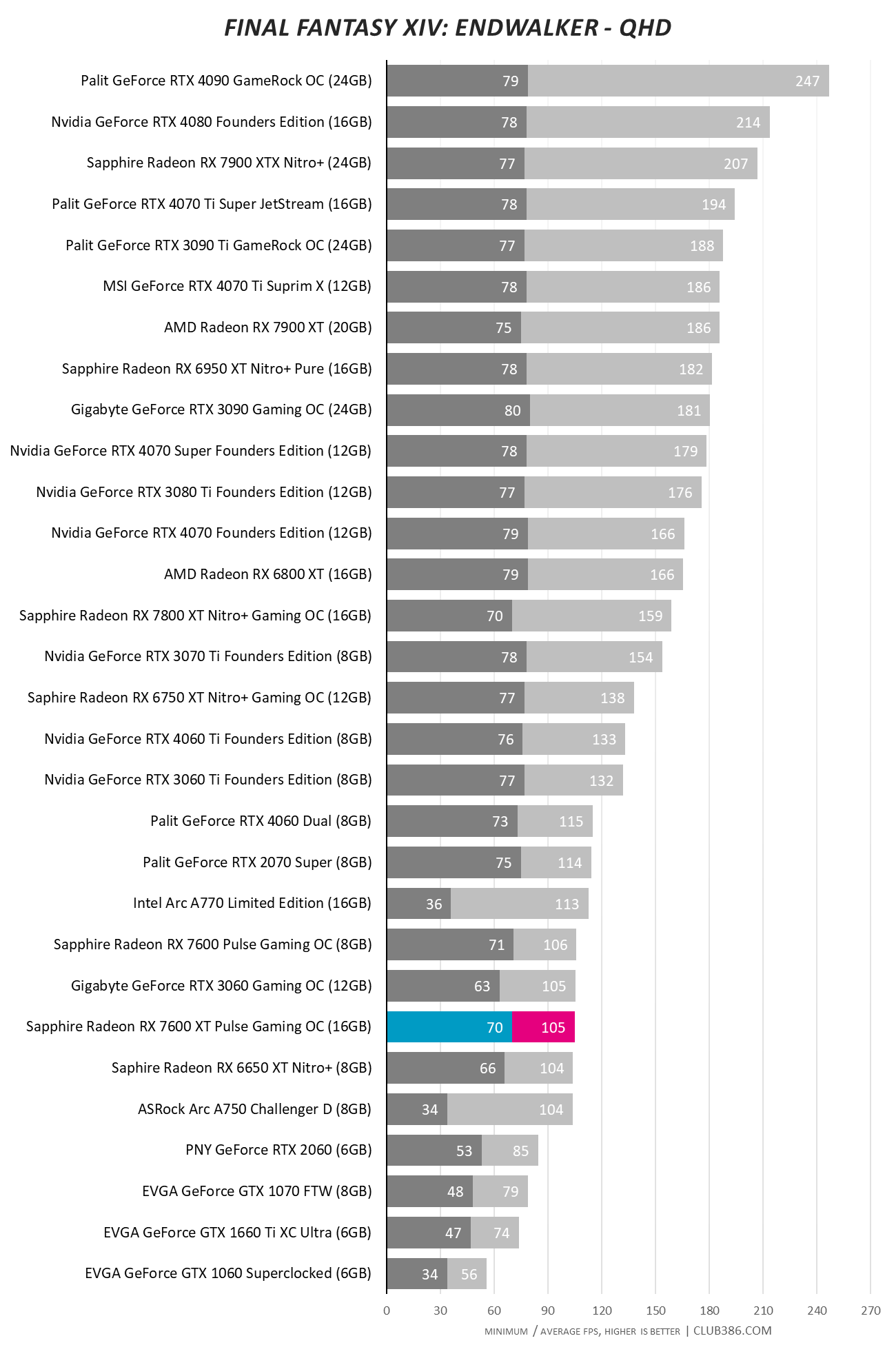
I’m not going to complain at QHD100, yet the spectre of the utility surrounding a mid-range card equipped with 16GB remains.
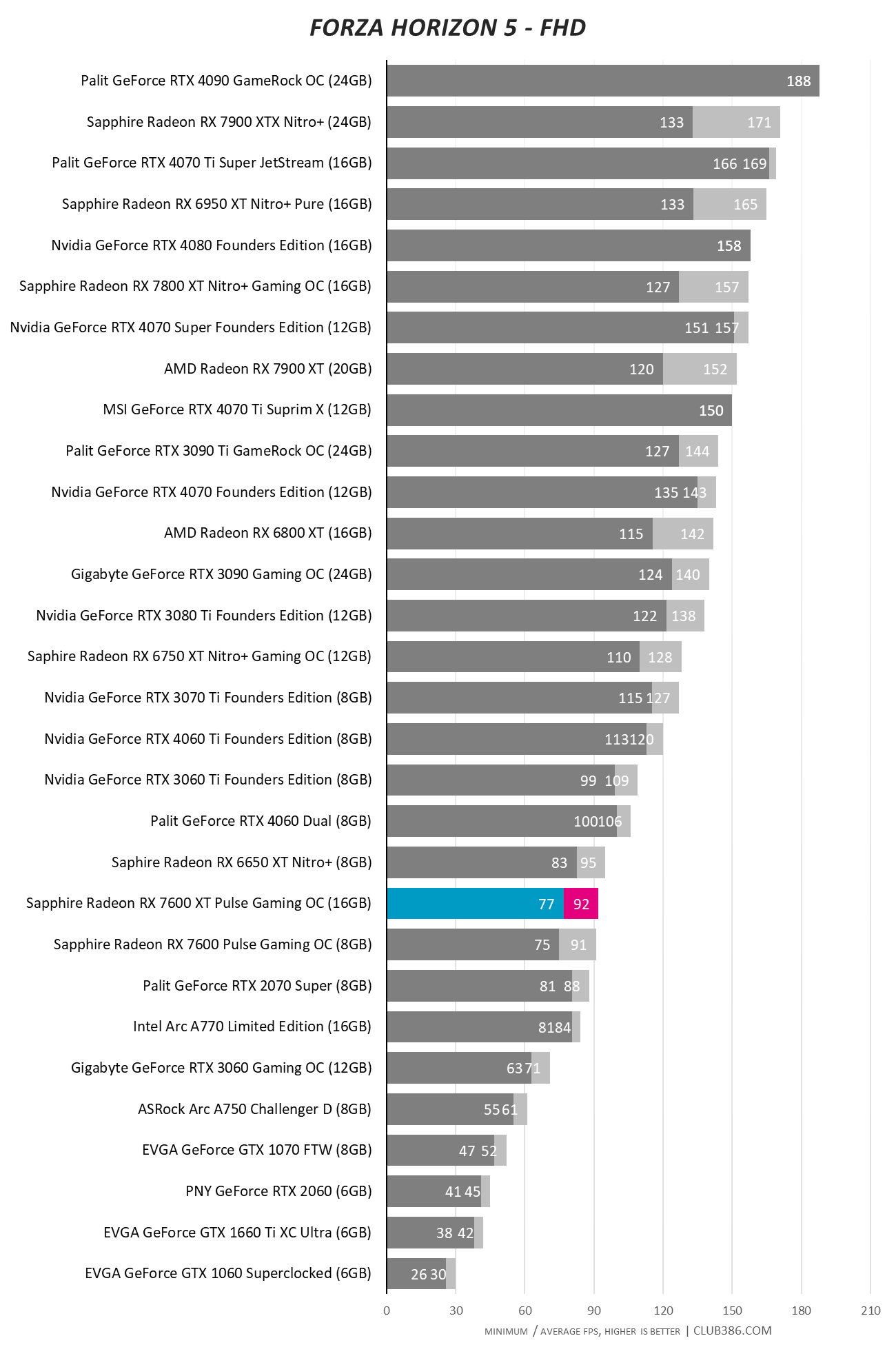
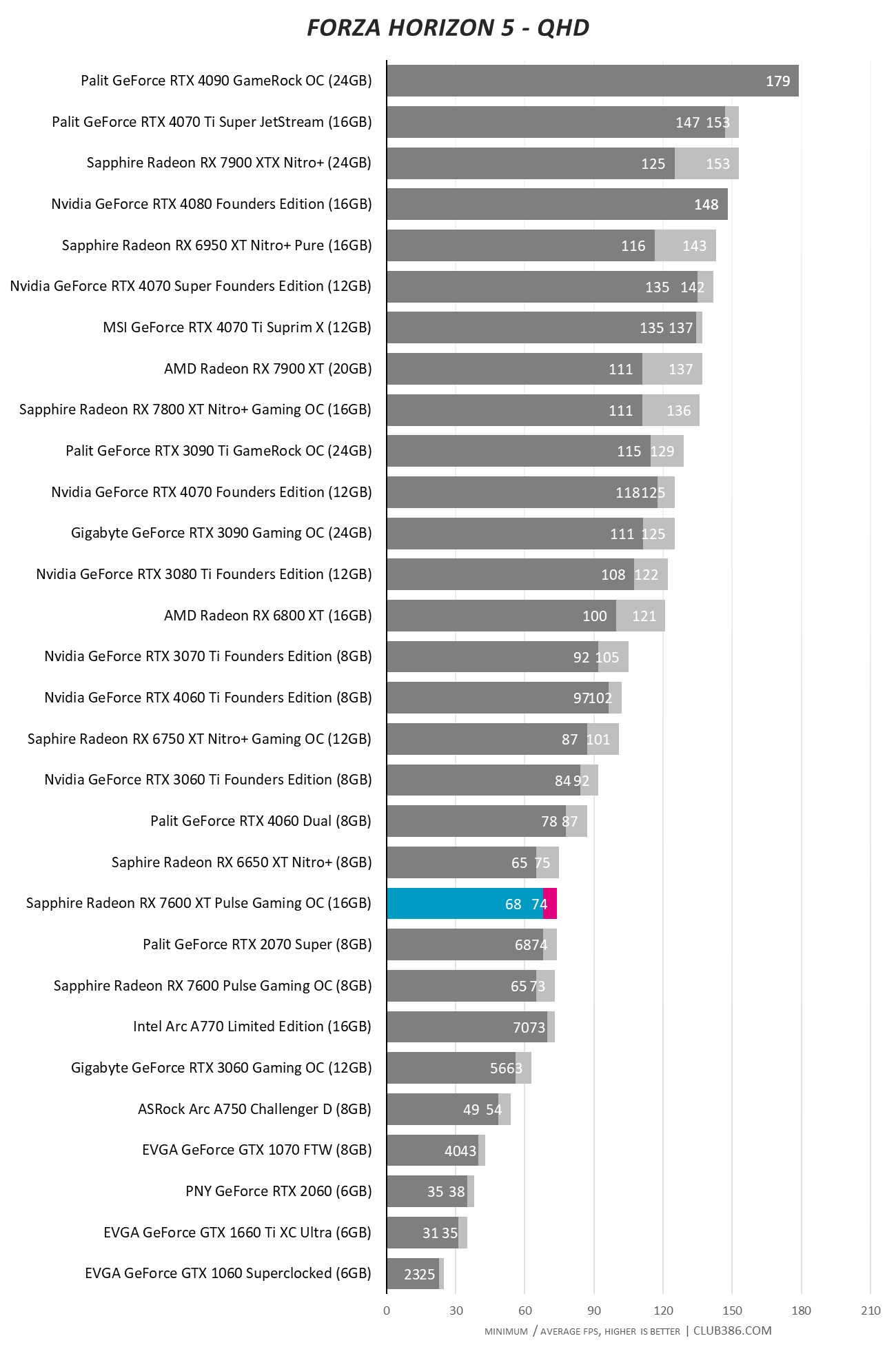
Considered in wider context, performance is more than acceptable at FHD and strong enough at QHD.
Try as I might, it’s difficult to engineer a situation where having 16GB on a Radeon RX 7600 XT makes real sense. There are corner cases, of course, but on the whole, 8GB is enough for a GPU of this intrinsic quality.
FSR examination

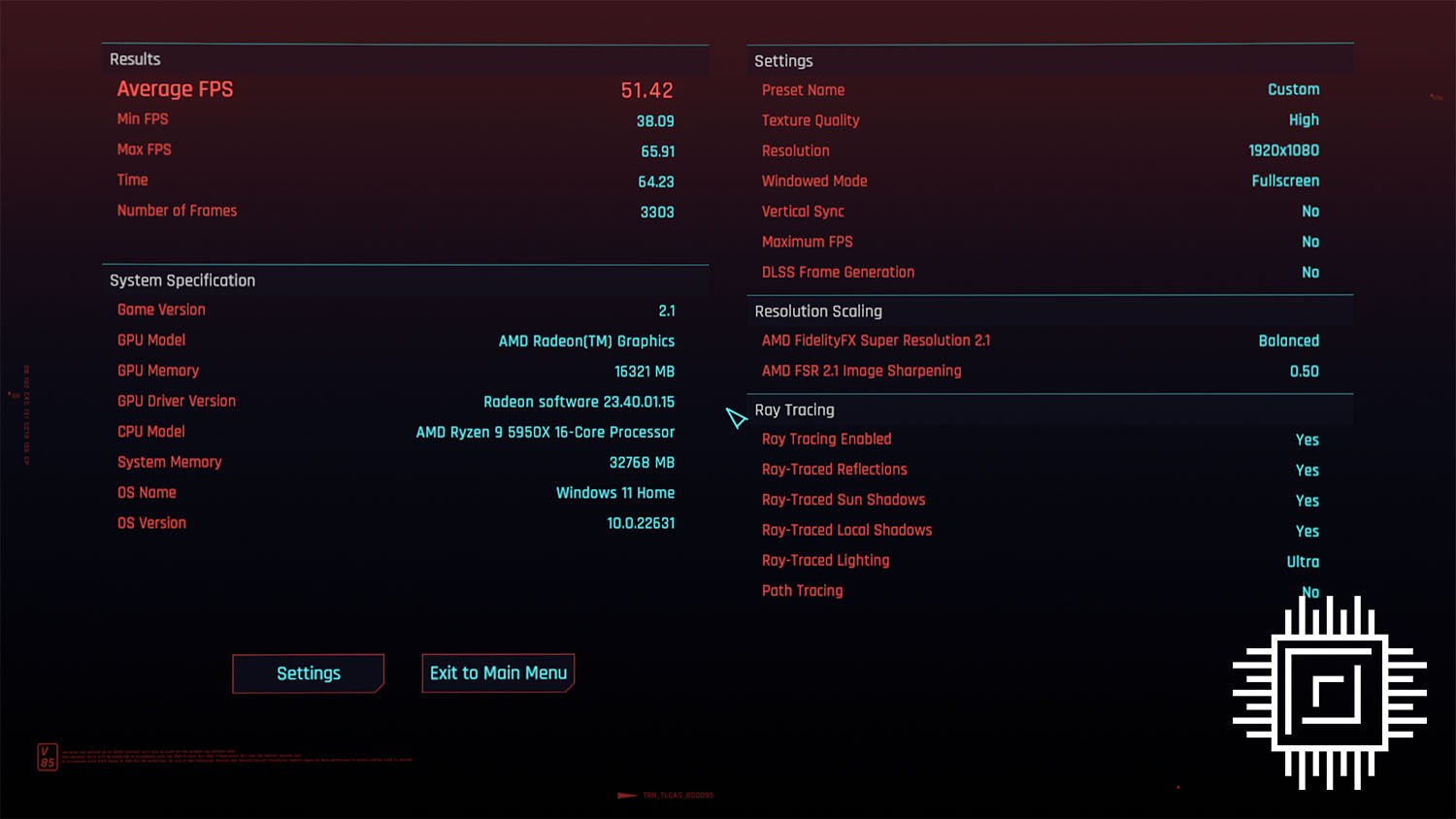

That pesky Cyberpunk 2077 sure does give the GPUs a good shellacking at these settings. Help is at hand, however, through the benefits of upscaling FSR 2.1 technology.
Recall the card scores an average 25fps at FHD. You can raise that to 41fps, 51fps, and 62fps when using Quality, Balanced, and Performance presets, respectively, turning the game from sticky to smooth. To be fair, I did notice some shimmering with the two latter settings, yet I’d strongly advise on using FSR if beautiful-looking reflections are important to you.
Efficiency
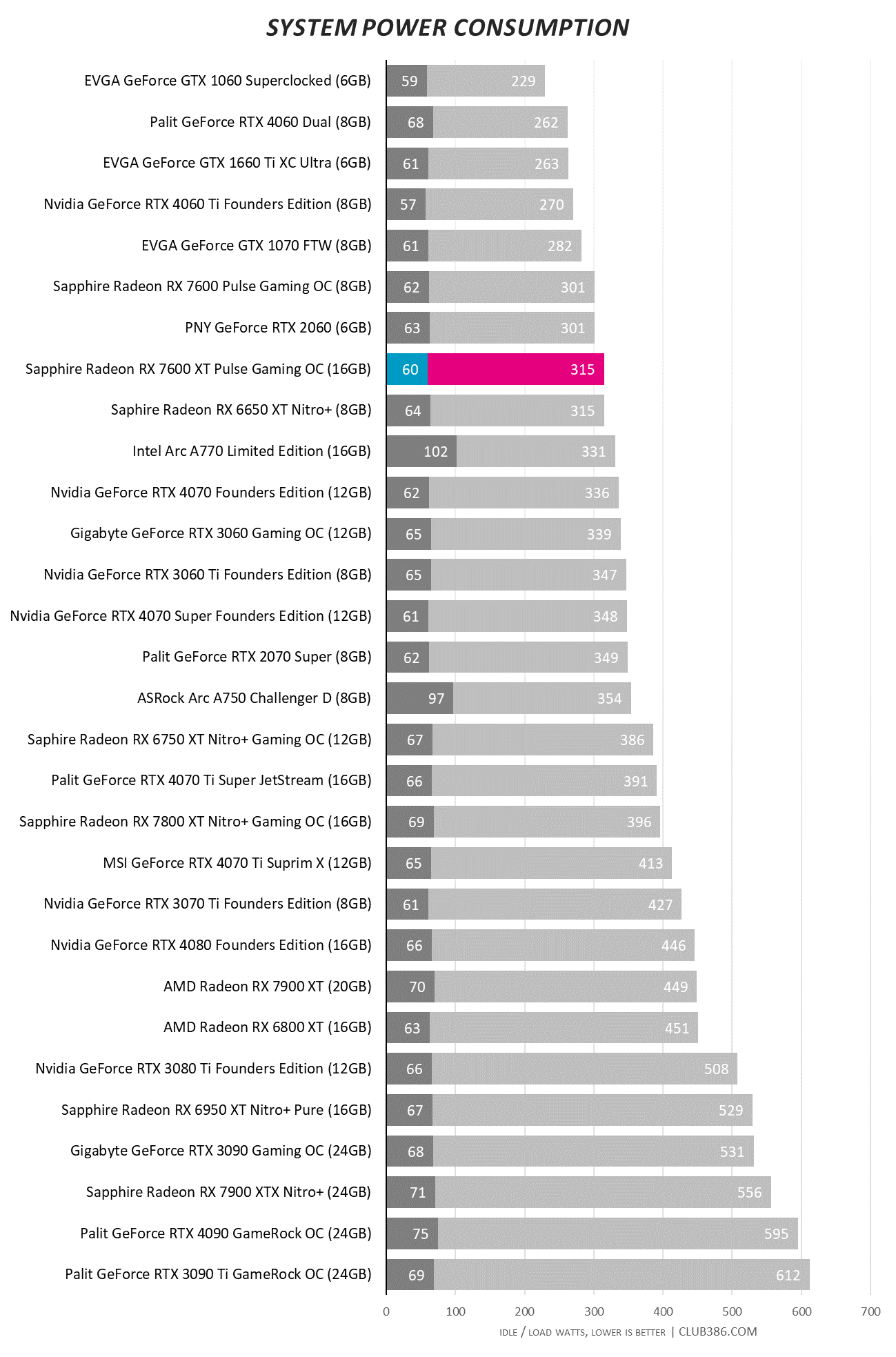
It’s reasonable to expect a little extra power over and above the 8GB model.
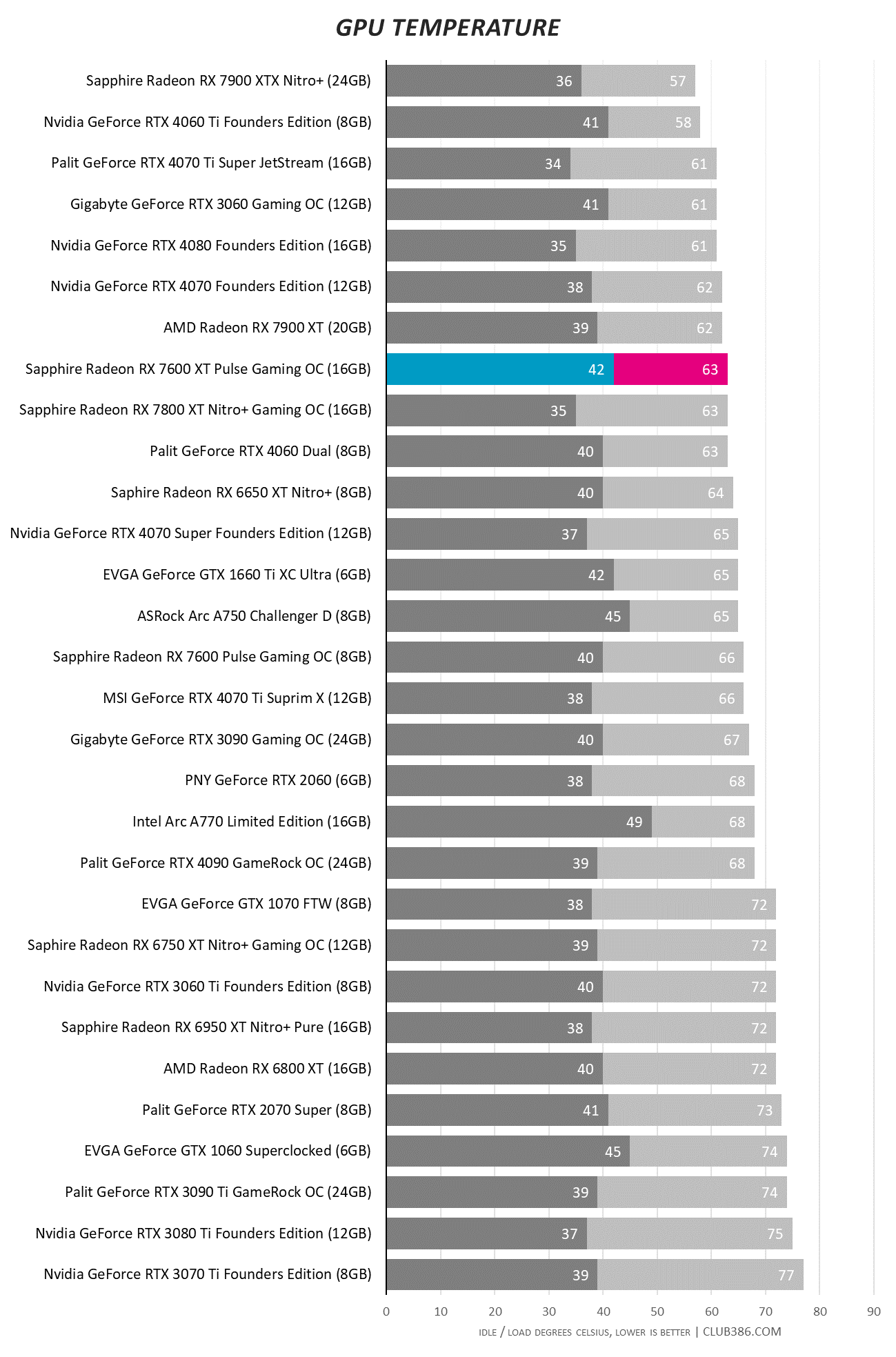
Sapphire is a past master at cooling Radeon GPUs. Absolutely no trouble in this regard.
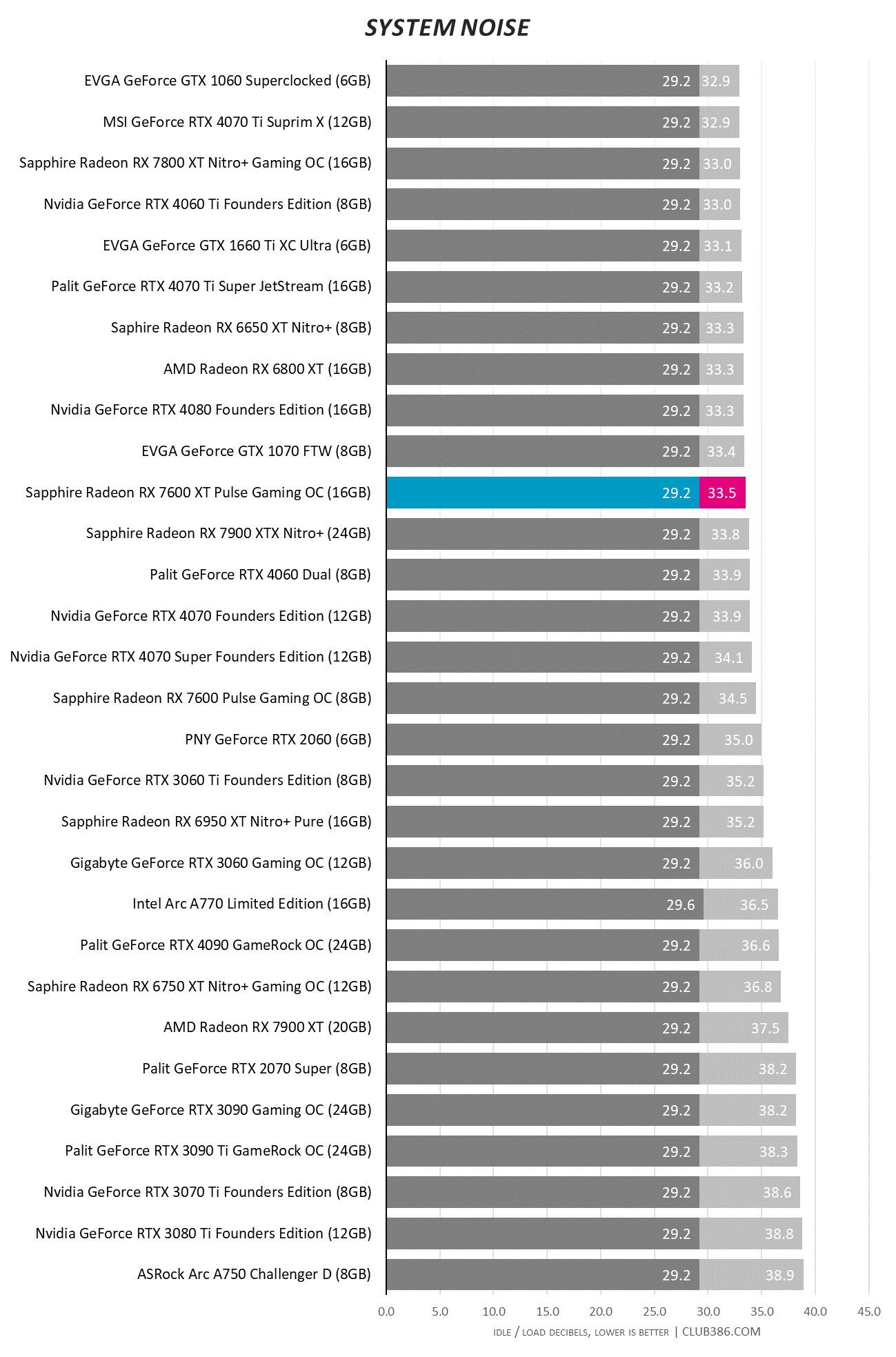
And noise is also on the lower end of the scale. I found it difficult to easily discern between an idle and load state, intimating a good fan profile.
Relative performance
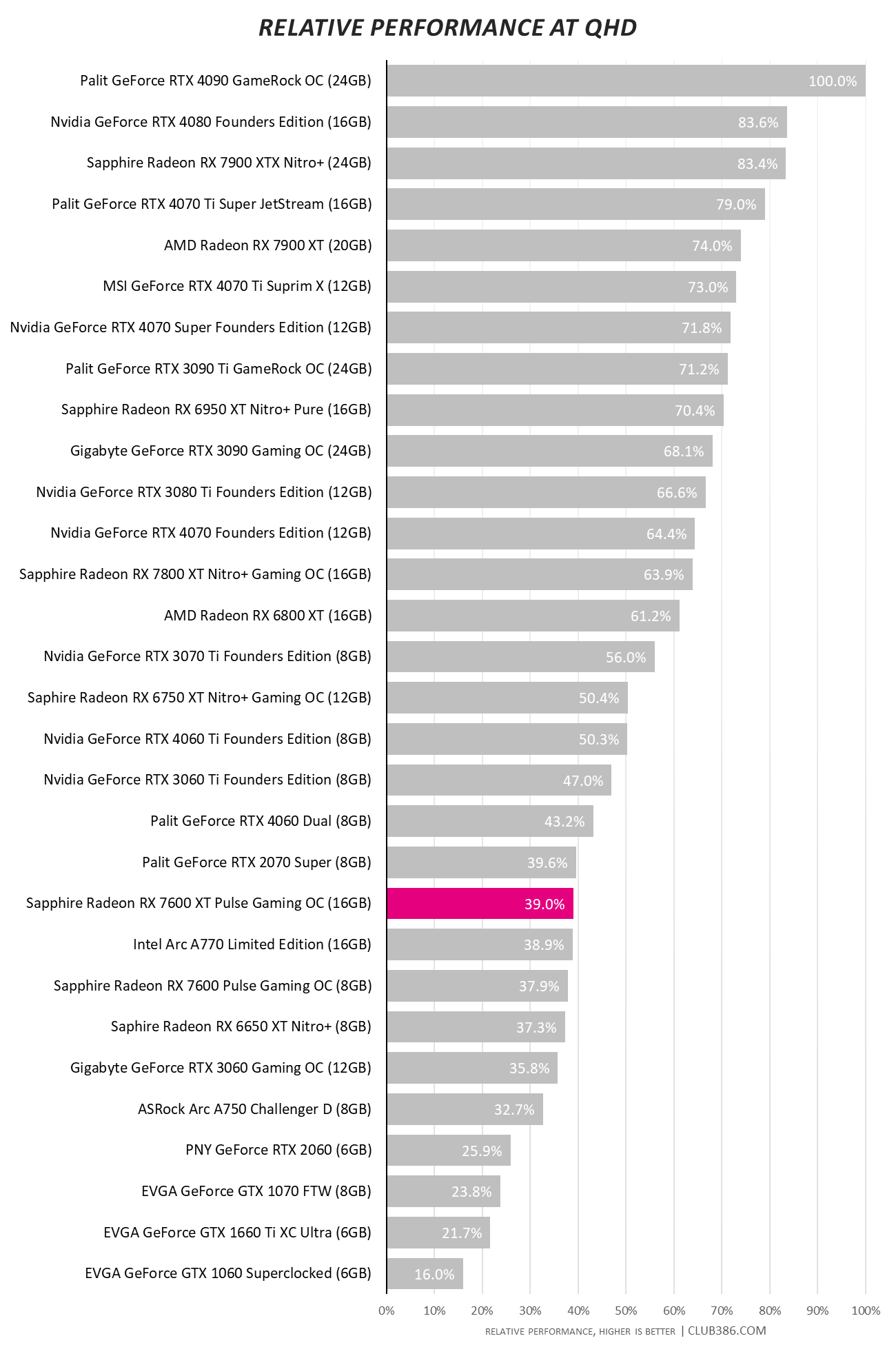
This graph looks at comparative performance in more detail. Perspective shows Sapphire’s Radeon RX 7600 XT 16GB is a touch quicker than a last-generation RX 6650 XT (8GB) and about on par with Intel’s Arc A770 LE 16GB. Sounds about right for $329, doesn’t it.
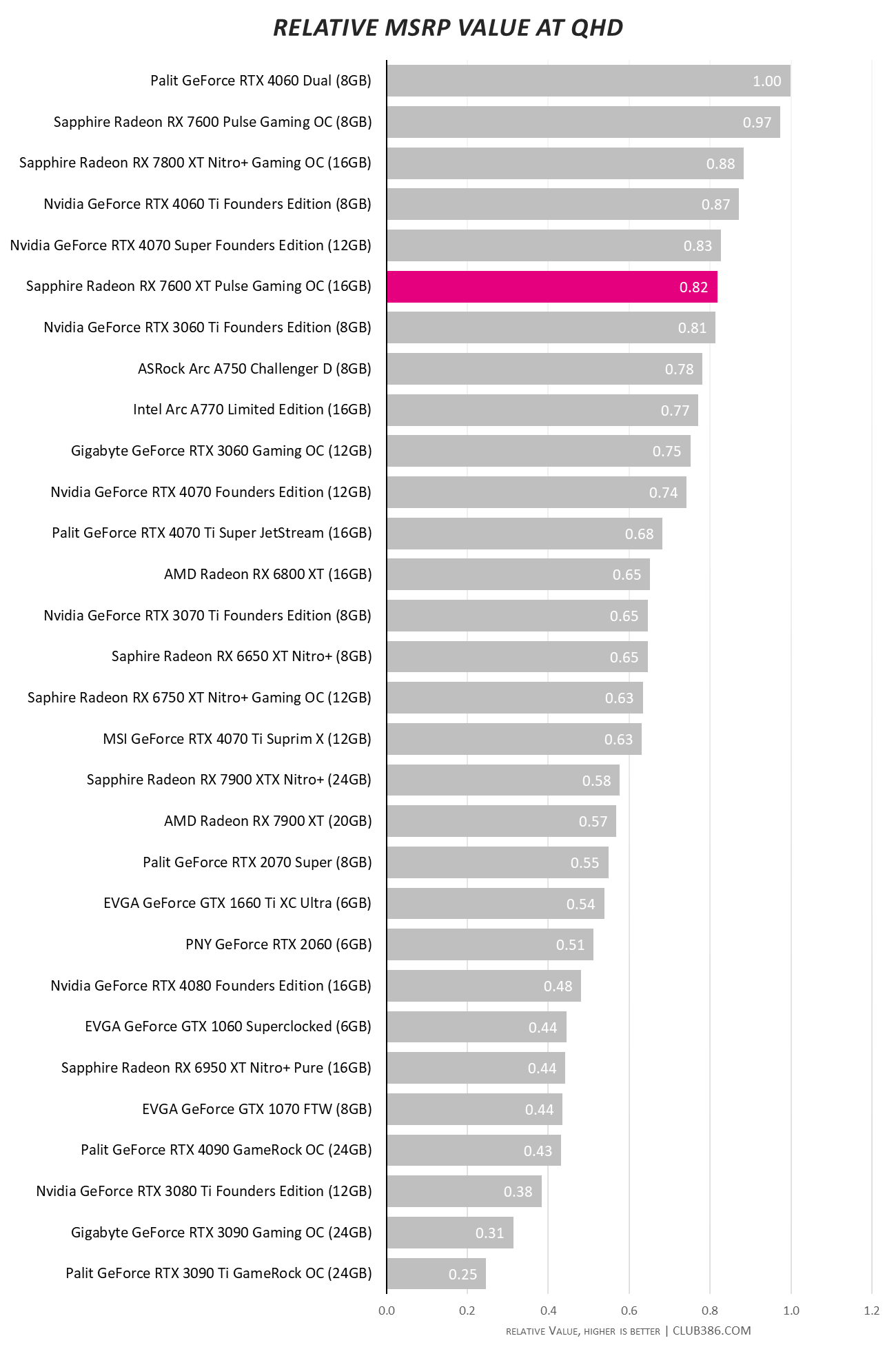
Vanilla Radeon RX 7600’s aggressive street price worked in its favour. That’s not as true for the 16GB card because it delivers a similar level of performance for a higher fee. Nevertheless, pricing is solid, as shown by our graph.
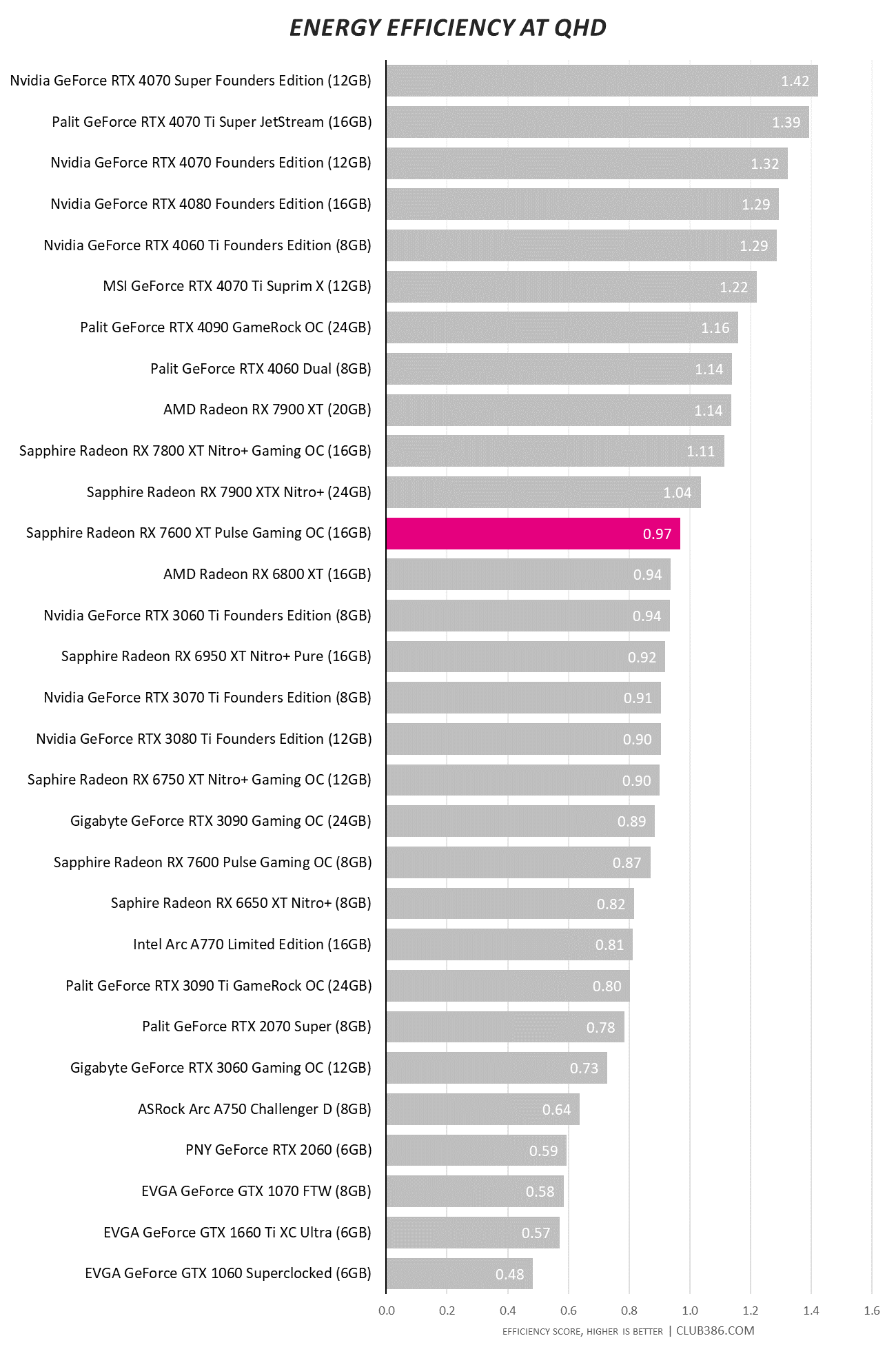
Venturing back to mid-pack territory, energy efficiency is exactly where I’d expect it to be.
Overclocking
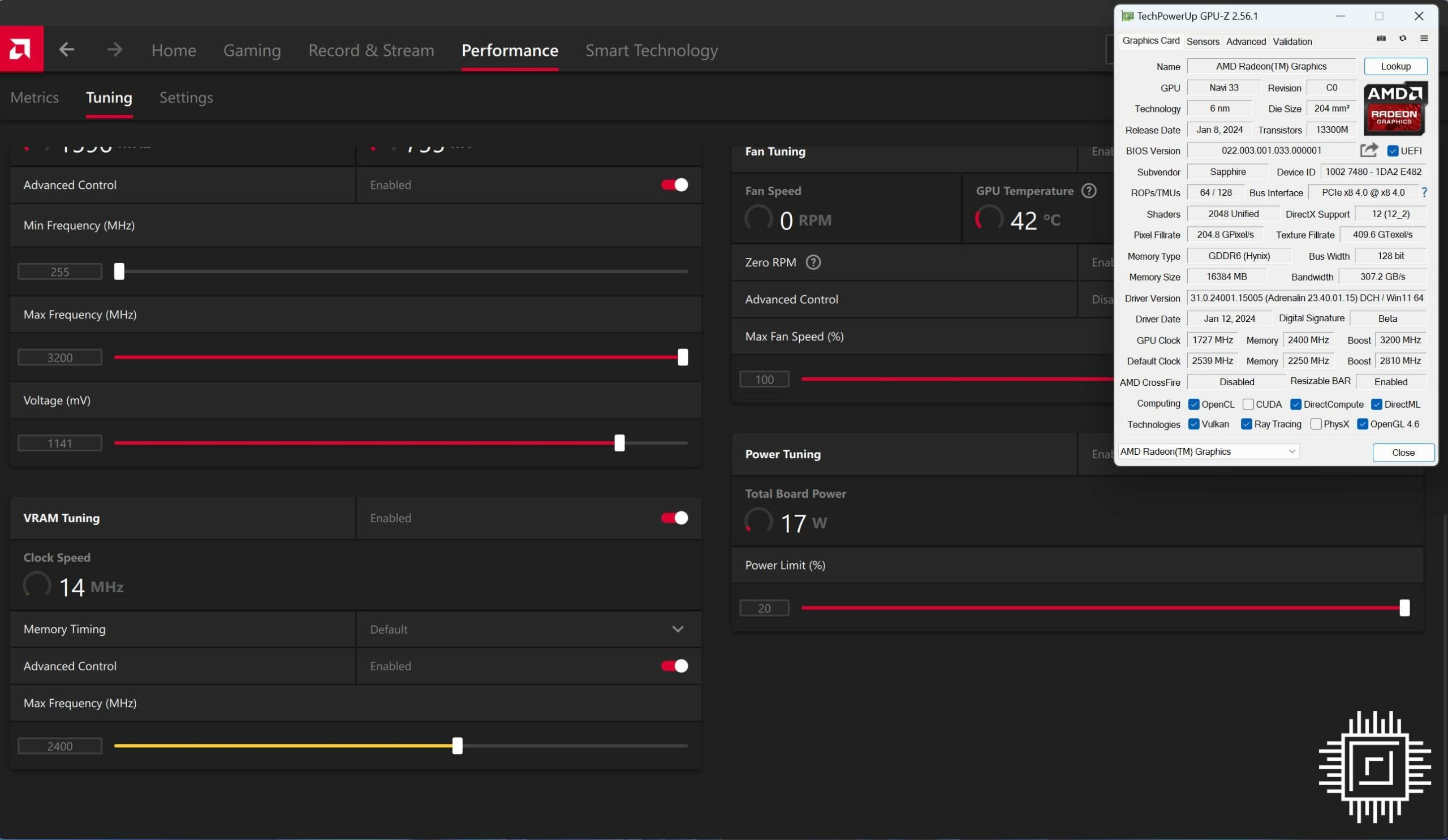
Fiddling around with frequencies and power targets yields higher clocks.
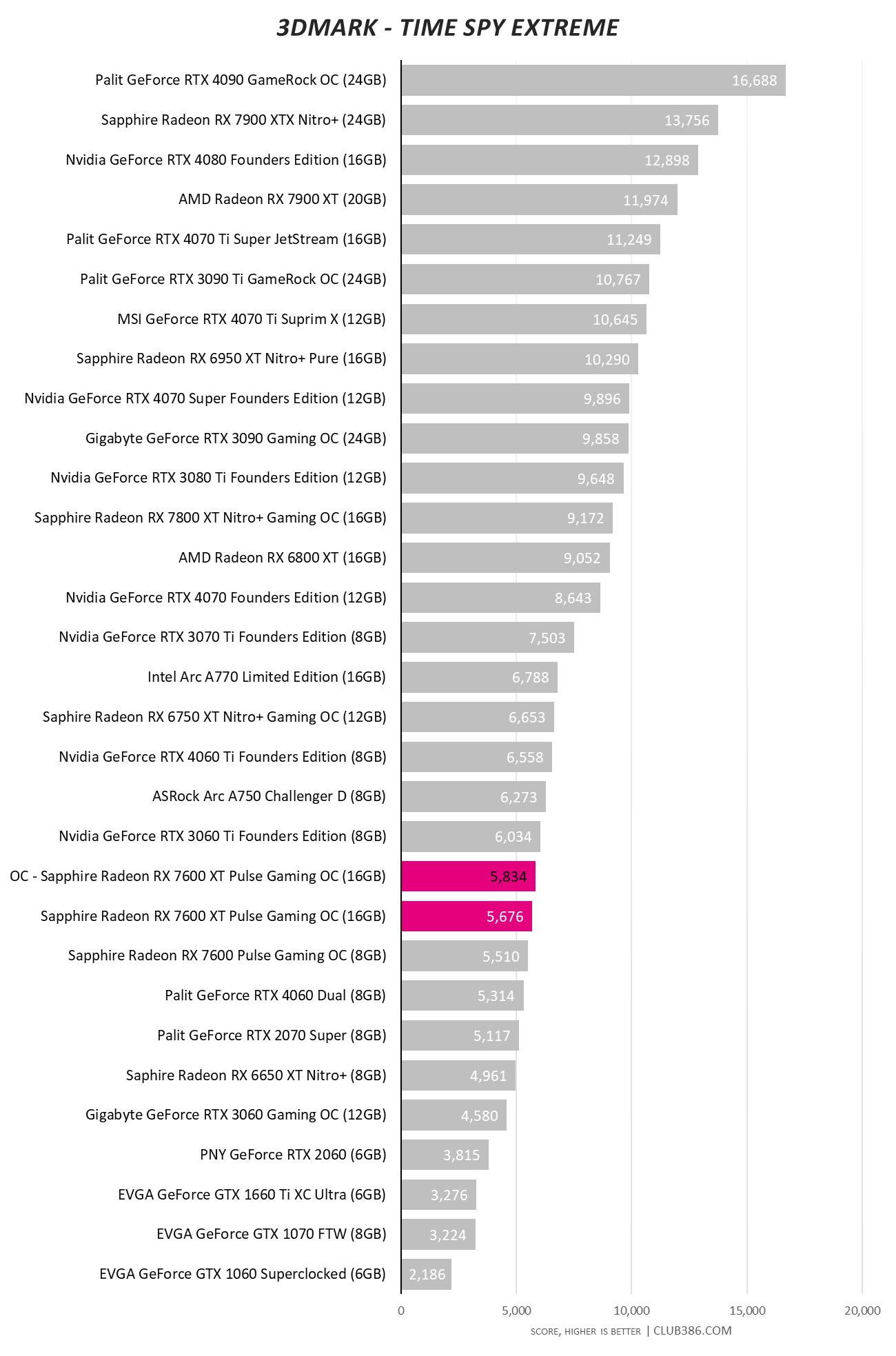
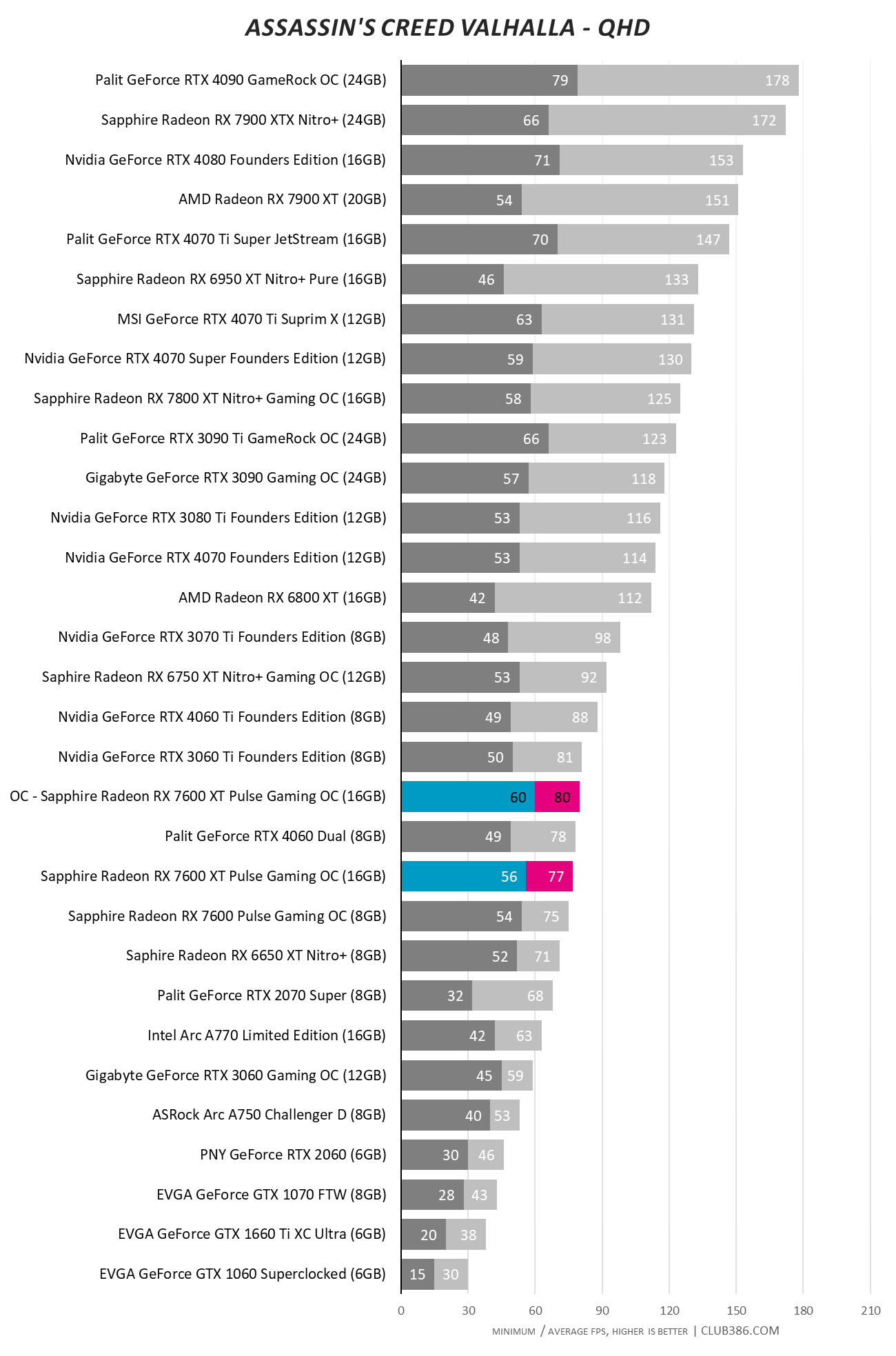
The real-world benefit is muted, so I’d leave this card at stock speeds.
Conclusion
Radeon RX 7600 XT 16GB arrives at a time marked by product refreshes rather than genuinely new models. Acutely aware of the value derived from last-generation cards still in the market, AMD’s decision to invigorate the RX 7600 with double the memory and a slight uptick in core frequency is an interesting move.
There’s little scope to do anything else, to be fair, so this new GPU exists to plug a price point rather than offer a meaningful performance jump over its Navi 33 sibling. Yet I have minor qualms about pricing, and I’d prefer this SKU launch at $299 / £299.
Nevertheless, gaming enthusiasts on a relative budget now have more choice than before. Adding an element of futureproofing, RX 7600 XT 16GB makes most sense if you plan to game at QHD with plenty of bells and whistles turned on, though advantages over 8GB are few and far between.
GPU musings aside, Sapphire does a great job in hitting MSRP with a Pulse Gaming OC card that carries on the good work of previous generations. It does everything you want and nothing you don’t, so if Radeon RX 7600 XT is your pick of mainstream GPUs, it’s a safe bet.
Verdict: a no-nonsense card based on AMD’s latest mainstream GPU, Sapphire’s Pulse is a good buy at below £300.

